




By Henry Empeño
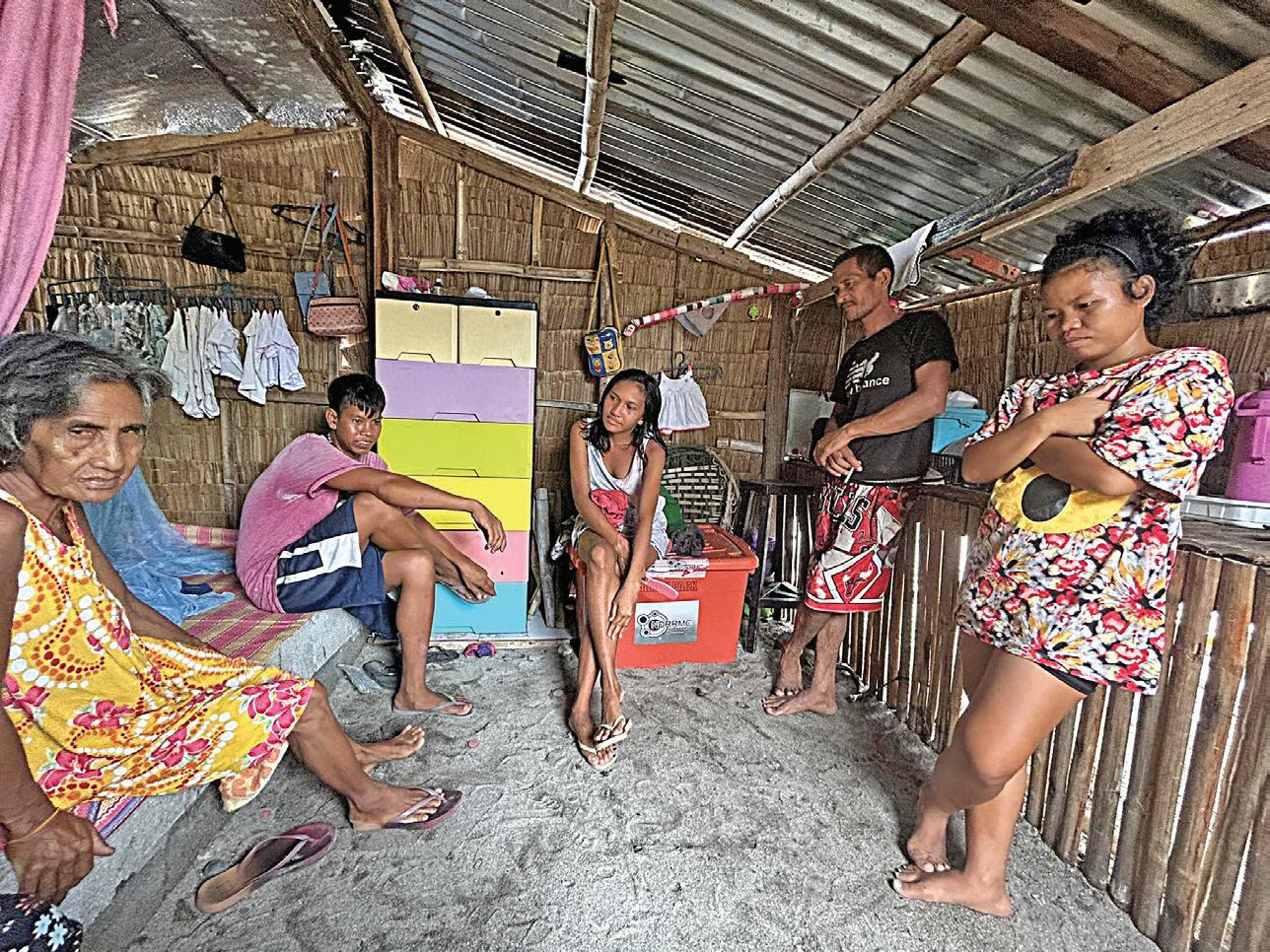
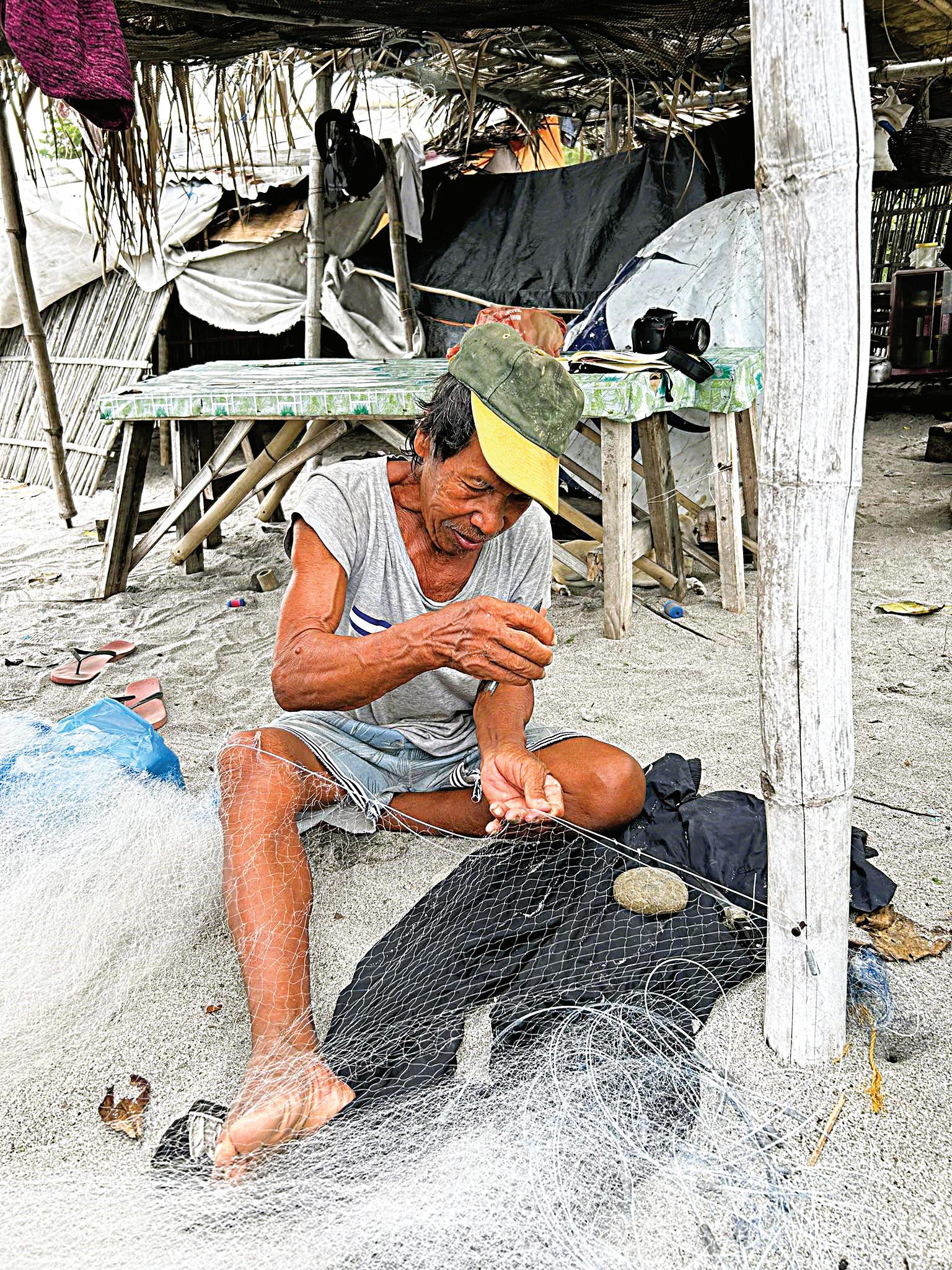
Chinese authorities reject $1-trillion housing rescue plan pitched by IMF
By Bloomberg News
CHINESE authorities have rejected a proposal made by the International Monetary Fund to use central government funds to complete unfinished housing, dealing a blow to hopes for more forceful support to an industry that’s been a major drag on the economy. The IMF called on China to deploy “one-off” fiscal resources to complete and deliver pre-sold properties or compensate homebuyers, according to an annual review of the world’s second-largest economy published Friday. It put the cost at the equivalent of 5.5% of gross domestic product over four years. That would amount to almost $1 trillion based on last year’s GDP, according to Bloomberg calculations. It’s a solution that China all but ruled out in an official response

included in the report. “We believe that we should continue to apply market-based and rule-of-law principles in completing and delivering these units,” said Zhang Zhengxin, the IMF’s executive director for China who was elected to the fund by the gov-
ernment in Beijing. “It would be inappropriate for the central government to directly provide fiscal support, as it could lead to expectation of future government bail-out and therefore moral hazards,” Zhang said. The IMF’s assessment hints
at the scale of the challenge facing China as it endures a prolonged housing downturn but remains reluctant to unleash a large fiscal stimulus or extend a lifeline to the market. The fund said it prepared the staff report in July following discussions with Chinese officials that ended in late May.
Zhang’s comments are “somewhat disappointing,” said Michelle Lam, Greater China economist at Société Générale SA, arguing that the government will eventually need to deviate from its approach and step up policy support for the housing market if the situation continues to deteriorate.
Drag on economy
CHINA’S housing travails have emerged as the largest obstacle to growth over the past two years.
Beijing’s approach has seemingly offered just enough help to





By Ma. Stella F. Arnaldo
The source pointed out that the new BI policy “may ultimately contravene the President’s instructions to pause e-visas for China,” even as DFA continues to process visitor visas with added security measures. BI is a unit of the Department of Justice (DOJ) and is tasked to protect the Philippines’ borders and ensure visiting foreign citizens comply with the country’s laws.
BI had recently come under fire from several lawmakers for its alleged “negligence” in allowing illegal aliens to continue working in the Philippines, as the Senate continues its investigation into the Philippine Offshore Gaming Operators (Pogo), which President Ferdinand Marcos Jr. banned, and gave a yearend deadline for winding down.
make sure the market adjustment doesn’t get out of control or trigger a financial crisis.
Authorities have been unwilling to extend more support to the housing sector in part because of top leaders’ determination to shift the economy’s growth driver away from property to technology and manufacturing.
The government has urged banks to lend to developers and stalled housing projects, while stopping short of providing direct funding.
In May, officials unveiled the biggest rescue package yet. It contains a 300 billion-yuan ($42 billion) central bank fund that attempts to help local governments buy finished but unsold homes and turn them into subsidized housing.
That’s aimed to reduce the massive housing inventory, but fell far short of the 1 trillion to 5 trillion yuan that some analysts said was needed to deliver a more decisive fix.
“The government is very unlikely to flip its policy overnight,” said Serena Zhou, senior China
economist at Mizuho Securities Asia Ltd.
Insolvent developers ON top of the funds needed to help absorb unfinished housing, the IMF reiterated a call for the government to accelerate the “resolution” or liquidation of insolvent developers, and allowing home prices to be more flexible.
“It will mitigate the risk of a larger and more protracted contraction in real estate investment and will help to rebuild confidence and boost consumption, thereby increasing growth and fiscal revenues in the medium term,” the fund said.
IMF staff conduct regular visits to member states that include meetings with local officials and then provide a report with accompanying analysis to the fund’s executive board for discussion. An Article IV consultation concludes with the presentation of the board’s views to the country’s authorities and its public release.
Across the country, tens of millions of apartments that are already sold to households have been delayed because struggling prop -
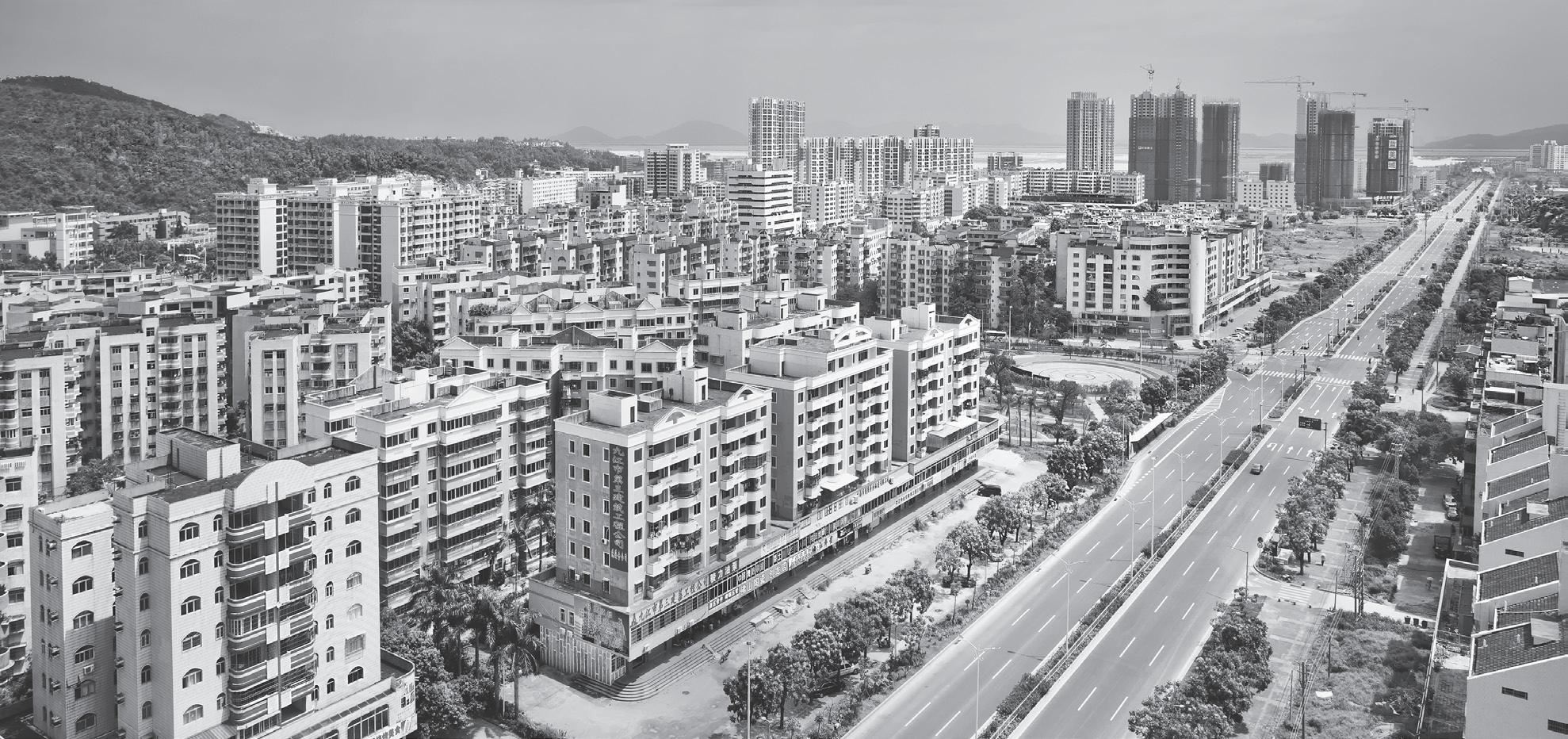
erty developers aren’t able to finish them, according to estimates by economists including Nomura Holdings Inc.’s Lu Ting. As a result, sentiment among homebuyers has suffered because people remain wary of acquiring properties only to find out they may never live there.
Deflation, subsidies SEPARATELY, the IMF warned of “significant downside risks” to

China’s inflation outlook, saying “a negative domestic demand shock amid high debt levels could trigger a period of sustained deflation.”
It estimates that real GDP in 2029 could be 5.4% lower in a scenario of prolonged deflation—or a period of declining prices—where
core inflation stays at minus 0.1% for five years. That could also lead to slower growth among China’s trading partners.
The fund additionally called on China to scale back its extensive use of industrial policies, which it says can create significant trade spillovers.
China’s has adopted around 5,400 subsidies from 2009 to 2022, two-thirds of the measures introduced by all Group-of-20 economies combined, according to the IMF. Chinese exports of subsidized products are 1% higher than those of non-subsidized products, the fund estimates.
Beijing responded to the suggestions by saying the rise of its emerging industries such as electric vehicles are driven by companies’ innovation instead of subsidies, according to Zhang’s statement.
Disjoint between DFA, BI IN a news conference recently, Senate President Francis “Chiz” Escudero pointed out the “apparent disjoint between the DFA and BI,” as the DFA issues tourists visas, which later are converted to work permits by BI.
He said in Filipino, “with all illegal Pogos that have been raided, most of the Chinese nationals arrested there are already illegal aliens. They arrived as tourists, had no work permits, or if they had, these were already expired, and yet why does [the BI] not seem to know about it?”
He added, “It would also be good to know from the BI how many work permits have been issued,” adding the DFA and BI don’t share information with each other on this matter. He also pointed out that “BI doesn’t have enough agents to monitor the millions of foreigners who were issued visas by the government.”
Escudero wondered if the
DOT’s inbound tourist arrivals data was still “correct or accurate” if its basis were the tourist visas issued, but there is an intention to work in the country. “Should we separate the tourist arrivals report from those who have their tourist visas converted to work permits here, so we have more accurate data as basis for planning [programs]?”
Boosting visitor arrivals
THE cruise visa waiver program was launched on July 16 by Tansingco and Tourism Secretary Christina Garcia Frasco, whose agency has prioritized cruise tourism as a program. Close to 80,000 cruise passengers are projected to arrive in the Philippines from 2024 to 2026, based on a partial report from the Department of Tourism (DOT), while data provided by the BI showed international cruise ships brought in 55,442 travelers last year. (See, “Cruise ships drop anchor the most in Palawan, Boracay,” in the BusinessMirror, June 3, 2024.)
The DFA and the DOJ-BI have been constantly at odds over the
fast-tracking of the issuance of tourist visas, with the latter siding with the DOT in trying to attract more foreign tourists to visit the Philippines, especially from China, which was the second largest tourism market in 2019, with 1.74 million. Several surveys have shown that while Chinese tourists are now increasing their travels abroad, most have chosen to visit countries with relaxed visa-entry policies such as Thailand, Singapore, Malaysia, to name a few. (See, “Balancing Act,” in the BusinessMirror, May 18, 2024.)
The joint project between the BI, DOT and DOJ simplifies the process of application by foreign cruise tourists to enter the Philippines through BI’s e-services portal, allowing “visa-required foreign nationals to enter the Philippines for a limited duration, strictly for cruise tourism purposes.” Tansingco added that the visa waiver is non-convertible and nonextendable, and will require the bearer to arrive and depart on the same cruise ship.
Continued from A1
These are residents of a oncethriving beach resort and fishing area at Barangay Camiing here who were displaced following a courtordered demolition last April.
Alvaro Nantona, 83, is among those who are trying to rebuild their lives following what residents described as a “traumatic ordeal” when heavy machinery tore down the houses they have lived in for decades.
“I started fishing here when I was just 16. We used to bring in tuna and squid from the reef just two kilometers from the shore,” Nantona recalled last week, as he was weaving a fishing net under a shed roofed with palm leaves.
This is where Nantona lives now: a derelict shack built from pieces of his former home. “I get wet a little when it rains hard, but I get by most times,” he told the BusinessMirror. “When a storm comes and the wind really hits strong, I transfer to the barangay hall and sleep there.”
Like most of the villagers affected by the demolition, Nantona has started building a new home at the relocation site proffered by the landowner, where each family was allocated a 500-square-meter lot.
Camiing barangay secretary
Jesse Abdon said a total of 110 families were affected by the demolition, but only 72 qualified for relocation.
House constructions are funded mostly with the P27,000 that each affected family received from the landowner following the demolition, and P15,000 in assistance from the local government, he said.
In a recent visit to Barangay Camiing, Gov. Hermogenes Ebdane Jr. announced that the fisherfolk affected by the demolition could avail themselves of P30,000 worth of materials from a local hardware on account of the provincial government. This is on top of the financial help the residents may get from local officials.
“This has been arranged already. They just have to coordinate with local officials to avail of the assistance,” Ebdane explained to the BusinessMirror last week.
Hope amid hardship WHILE some villagers said the P42,000 they received was not enough to complete a decent shelter, Clarita Ladao-Biay and her family had recently finished their dwelling at the relocation site.
It isn’t anything fancy: the roofing is GI sheets, but the walls are thatched nipa. An elevated part
left of the doorway serves as bedroom, and across the dirt floor is a banggera, where cooking and eating utensils are arranged on bamboo slats.
“We’re okay here,” the 75-yearold Clarita said. “What matters is that we have shelter from the rain.”
“This is actually a bigger house, but we also miss the old one,” chimed in Alvin, 34, one of Clarita’s children, who shares the new dwelling.
Aside from giving shelter, the new homes are proving to be a beacon of hope for the villagers of Talisay.
Joneil Carmona, 32, said the demolition traumatized the fisherfolk because they were uprooted from a place they have lived in since childhood.
“Most of us were not able to go out to fish when the demolition happened. We were unsure of what would happen to us, because we didn’t have anything to come back to,” he said.
Holmalyn Flores, 43, added that even the schooling of their children suffered after the demolition, as residents prioritized rebuilding dwellings from what scraps they could scavenge from the demolished ruins.
“But we’re doing all right now. Slowly, we’re getting back on our feet,” Flores said.
Editor: Angel R. Calso

By Justin Spike The Associated Press
BUDAPEST, Hungary—In the months leading up to elections for the European Parliament, Hungarians were warned that casting a ballot against Prime Minister Viktor Orbán would be a vote for all-out war.
The right-wing Fidesz party cast the June 9 election as an existential struggle, one that could preserve peace in Europe if Orbán won—or fuel widespread instability if he didn’t. To sell that bold claim, Orbán used a sprawling progovernment media empire that’s dominated the country’s political discourse for more than a decade.
The tactic worked, as it has since Orbán returned to power in 2010, and his party came first in the elections—though not by the margins it was used to. An upstart party, led by a former Fidesz insider, attracted disaffected voters and took 29% of the vote to Fidesz’s 44%.
“Everything has fallen apart in Hungary. The state essentially does not function, there’s only propaganda and lies,” said Péter Magyar, the leader of that new party who has emerged in recent months as perhaps the most formidable challenge yet to Orbán’s rule.
Magyar’s Respect and Freedom (TISZA) party campaigned on promises to root out deep-seated corruption in the government. He has also been outspoken about what he sees as the damage Orbán’s “propaganda factory” has done to Hungary’s democracy.
“It might be very difficult to imagine from America or Western Europe what the propaganda and the state machinery is like here,” Magyar said in an interview before elections with The Associated Press. “This parallel reality is like the Truman Show. People believe
that it’s reality.”
Since 2010, Orbán’s government has promoted hostility to migrants and LGBTQ+ rights, distrust of the European Union, and a belief that Hungarian-American financier George Soros—who is Jewish and one of Orbán’s enduring foes—is engaged in secret plots to destabilize Hungary, a classic antisemitic trope.
Such messaging has delivered Orbán’s party four consecutive two-thirds majorities in parliament and, most recently, the most Hungarian delegates in the EU legislature.
But according to Péter Krekó, an analyst and head of the Political Capital think tank in Budapest, Orbán has created “an almost Orwellian environment” where the government weaponizes control of a majority of news outlets to limit Hungarians’ decisions.
“Hungary has become a quite successful informational autocracy, or spin dictatorship,” Krekó said.
The restriction of Hungary’s free press directly affects informed democratic participation. Opposition politicians have long complained that they only get five minutes of airtime every four years on public television, the legal minimum, to present their platforms before elections.
In contrast, public television and radio channels consistently echo talking points communicated both by Fidesz and a network

of think tanks and pollsters that receive funding from the government and the party. Their analysts routinely appear in affiliated media to bolster government narratives, while independent commentators rarely, if ever, appear.
During the campaign in May, Hungary’s electoral commission issued a warning to the public broadcaster for repeatedly airing Fidesz campaign videos during news segments, a violation of impartiality rules. The broadcaster carried on regardless.
Magyar, who won a seat in the European Parliament, credits his new party’s success partly to its ability to sidestep Orbán’s dominance by meeting directly with voters and developing a large following on social media.
But in largely rural Hungary, even those with a strong online presence struggle to compete with Fidesz’s control of traditional outlets.
According to press watchdog Reporters Without Borders, Orbán has used media buyouts by government-connected “oligarchs” to build “a true media empire subject to his party’s orders.” The group estimates that such buyouts have given Orbán’s party control of some 80% of Hungary’s media
market resources. In 2021, it put Orbán on its list of media “predators,” the first EU leader to earn the distinction.
The title didn’t come out of nowhere: in 2016, Hungary’s oldest daily newspaper was suddenly shuttered after being bought by a businessman with links to Orbán.
In 2018, nearly 500 pro-government outlets were simultaneously donated by their owners to a foundation headed by Orbán loyalists, creating a sprawling right-wing media conglomerate. And in 2020, nearly the entire staff of Hungary’s largest online news portal, Index, resigned en masse after its lead editor was fired under political pressure.
A network of independent journalists and online outlets that continue to function in Hungary struggles to remain competitive, said Gábor Polyák, head of the Media and Communication Department at Eötvös Loránd University in Budapest.
The government is the largest advertiser in Hungary, he said. A study by watchdog Mérték Media Monitor showed up to 90% of state advertising revenue is awarded to pro-Fidesz media outlets, keeping them afloat.
The government’s efforts to
control media have moved beyond television, radio and newspapers, shifting into social media posts that are boosted by paid advertisements.
Hungary spent the most in the entire 27-member EU—nearly $4.8 million—on political ads on platforms owned by Facebook’s parent company, Meta, in a 30-day period in May and June, outspending Germany, which has more than eight times the population, according to a recent report based on publicly available data compiled by Political Capital, Mérték Media Monitor and fact-checking site Lakmusz.
The vast majority of that spending came from Fidesz or its proxies, the report found.
One major spender is Megafon, a self-declared training center for aspiring conservative influencers. In the same 30-day period, the group spent $800,000 on boosting its pro-government content on Meta platforms, more than what was spent in total by 16 EU countries in the same period.
With government narratives so pervasive across mediums, a level of political polarization has emerged that can reach deep into the private lives of Hungarians. In recent years, the views of Andrea Simon, a 55-year-old entrepreneur from a suburb of Budapest, and her husband Attila Kohári began to drift apart—fed, according to Simon, by Kohári’s steady diet of pro-government media.
“He listened to these radio stations where they pushed those simple talking points, it completely changed his personality,” Simon said. “I felt sometimes he’d been kidnapped, and his brain was replaced with a Fidesz brain.”
In December, after 33 years of marriage, they agreed to divorce.
“I said to him several times, ‘You have to choose: me or Fidesz,’” she said. “He said Fidesz.”
Still, like many Hungarians who hold fast to traditional values in a changing world, Kohári
remains a faithful supporter of Orbán and his policies, despite the personal cost.
His love of his country and belief that Orbán has led Hungary in the right direction have him “clearly convinced that my position is the right one,” he said. “But it ruined my marriage.”
The media divide also has consequences for Hungary’s finances, says independent lawmaker Ákos Hadházy, who has uncovered dozens of suspected cases of graft involving EU funds.
Such abuses, he said, go largely unaddressed because the majority of voters are unaware of them.
“Following the Russian model, (the government) controls state media by hand and spends about 50 billion forints ($135 million) a year on advertisements … that sustain their own TV networks and websites,” he said. “The people that consume those media simply don’t hear about these things.”
On a recent day in Mezőcsát, a small village on the Hungarian Great Plain, Hadházy inspected the site of an industrial park that was built with 290 million euros ($310 million) in EU funds. The problem, he said, is that since the site was completed in 2017, it has never been active, and the money used to build it has disappeared.
Hadházy said that Hungarians “who consciously seek out the real news hear about these cases and don’t understand how it’s possible that there are no consequences when I present such things almost daily.”
He continued: “But it’s not important for the government that nobody hears about them, it’s important that more people hear their lies, and that’s the way it is now. Far more people hear their messages than the facts.”
This story, supported by the Pulitzer Center for Crisis Reporting, is part of an ongoing Associated Press series covering threats to democracy in Europe.
By Kanis Leung The Associated Press
HONG KONG—After spending five months in jail for publishing seditious Instagram posts, Joker Chan returned to a harsh reality. Chan, 30, was sentenced in 2022 for posts containing slogans like “Liberate Hong Kong, revolution of our times,” which were popularly chanted during massive anti-government protests in the city in 2019. Authorities said such slogans could imply separating Hong Kong from China—a red line for Beijing.
Upon his release, Chan’s criminal record barred him from returning to the hotel industry, where he previously worked as a chef. Tattoos on his arms, legs and the sides of his neck—some related to the protests—made his job search more difficult. Now, he works as a part-time waiter, earning about half of what he used to make.
Some of his friends severed ties with him, fearing their association might lead to police investigations. His family also expressed disappointment in him, and when he went out with other former protesters they asked him whether he planned to stir trouble.
“I felt helpless. I can’t understand this,” he said, wearing a black t-shirt that read “I am
Hongkonger” and with a tattoo of his inmate number on his arm.
Five years after the protests erupted, the lives of some young people who were jailed or arrested during Beijing’s political crackdown on the city’s pro-democracy movement remain in limbo. Unlike famed activists, these former protesters usually receive little attention from most of the city, even though their activism for the same democratic goals has exacted a similarly heavy toll.
Since the protests broke out five years ago, more than 10,200 people have been arrested in connection with the often-violent social unrest sparked by a now-withdrawn extradition bill, which would have allowed suspects in Hong Kong to be sent to mainland China. According to police, about one-fifth of them have faced or were facing “legal consequences” as of the end of May.
The government crackdown expanded after Beijing imposed a national security law in 2020 and the enactment of similar, homegrown legislation in March. About 300 others were arrested under the two security laws and other offenses linked to endangering national security as of June, with half of them already convicted by courts, the city’s security bureau said.
Chan fought for a more democratic Hong Kong, a goal that many

in the city have yearned for since the former British colony returned to China in 1997. Reflecting on his actions, Chan said he would have been more cautious if he could go back in time, but he doesn’t regret what he did.
“Regret can lead you to overturn what you originally firmly stood for,” he said.
Chan was an exception in agreeing for his full name to be published in this article. Two other interviewees The Associated Press spoke with asked to be identified only by partial names over fears of government retribution.
Another former inmate, also surnamed Chan, said he panicked
every time he saw police on the streets after he finished serving his sentence in 2022, worrying he would be arrested again. Chan, who is in his 20s, refused to provide more details about his prosecution since he feared being identified by authorities.
Before he landed his current job in the creative industry, he sent applications to about 40 companies seeking employment, with only a handful offering him an interview. He said one interviewer was concerned that convicted people like him could affect their corporate image.
Even when he secured a position at another firm, he said he
was treated unfairly by former pro-China colleagues. He said they also did not allow him to work on certain projects.
“Some (who were jailed) for political cases like me, when released, are treated as pariahs in society in a hidden manner,” he said.
Others who did not go to jail have also lived in fear for years.
Nick, a former protester who was arrested in 2019, said he didn’t know for years whether he would be charged until police this year confirmed they had dropped his case.
Brandon Yau, secretary of the prisoners’ support group Waiting Bird, said while some former inmates could return to the industries they previously worked in, many teachers, medical professionals and social workers—whose positions are linked to a license or public sector organizations—face greater challenges in returning to their old sectors.
Convicted students who were formerly jailed are concerned about whether schools will accept them. Some institutions have been unsupportive of their students after they were arrested, Yau said.
According to his group, many of the hundreds of convicts they supported are expected to be released in the next two years. Yau said the city should plan for ways to accommodate them.
Official data show hundreds of people were sent to correctional services facilities each year over offenses linked to the protests or for allegedly endangering national security between 2020 and 2023. By the end of 2023, about 780 people were in custody for such offenses, up nearly 50 percent from a year earlier.
Hong Kong’s security minister Chris Tang previously said many young people who were jailed over civil disturbances were influenced or incited by others and went astray. He said local society won’t give up on them as long as they “genuinely” want to turn over a new leaf.
But critics say Tang’s remarks overlook the deeper grievances and aspirations that drove young people to protest five years ago.
Paul Yip, a professor at The University of Hong Kong’s department of social work and social administration, said local employers were becoming more accepting of these young people, possibly after seeing former inmates perform well in their jobs.
Yip, also the director of a suicide prevention research center, said the young people he hired were enthusiastic about their future and usually had a strong sense of responsibility.
He said it is important to help such people get back on track.
By Jack Sidders, Neil Callanan & Laura Malsch
AFTER trying and failing to sell office buildings from Paris to Frankfurt, Amundi SA is finally nearing a sizable disposal that will help raise cash for investors who want out of its property funds.
Blackstone Inc. agreed to buy a group of business parks for €250 million ($270 million) to €300 million from Europe’s largest asset manager, according to people with knowledge of the matter. The US investment firm is betting some will have a more profitable future once they’re turned into dedicated logistics facilities, the people said.
The deal highlights an increasingly critical dilemma for openended property funds in Europe, investment vehicles that oversee some €166 billion in assets. In a world where office buildings are out of favor, one of the few ways to meet redemptions is to sell other, more attractive assets, such as residential buildings, warehouses or properties than can be transformed for such uses.
That’s leaving fund managers— and their remaining clients—with an increasing concentration in beaten-up segments of the market. With redemptions continuing, some of them may soon have no choice but to sell, triggering revaluations and delaying any nascent market recovery, with potential ripple effects across the economy.
For some property funds and developers, “the pressure to sell is insanely high,” said Henning Koch, the chief executive officer of Commerz Real AG, a German fund manager that oversees about €34 billion in real estate and renewables. “Funds are struggling with outflows.”
Open-ended property funds in Europe have seen six consecutive quarters of outflows, according to Morningstar Inc. The data showed investors have pulled more than
€12 billion since the European Central Bank began raising interest rates in July 2022, leaving net assets at the lowest level in five years.
For mutual funds that invest in stocks or bonds, such redemptions would be painful but they wouldn’t create liquidity or concentration issues because the securities are regularly priced on a public market and sold easily.
Property funds, by contrast, buy large assets that can’t be traded speedily and whose current value can be difficult to ascertain until they’re sold again, sometimes at significant discounts to what the fund had ascribed to them.
For open-ended funds, that can make it difficult to sell assets when investors want out, creating a potential liquidity mismatch. About €74 billion of commercial real estate deals were completed in total in the first half of this year in Europe, 42 percent below the five-year average, according to Savills. If funds do sell, it’s easier to dispose of properties where there are better prospects for rental growth and delay revaluing the less popular assets.
In Germany, many funds are struggling to offload assets because of rules that prohibit them from selling assets significantly below book value. If they do, they’re required to reassess the portfolio or property for sale, which can trigger steep changes in the fund’s value. Some managers are currently considering securing new credit lines from their banks for real estate they own to avoid

revaluations of the assets and potential sales, two people with knowledge of the matter said.
Others recognize the pain. Union Investment cut the net asset value of a €4 billion fund by 17 percent last month, after it was unable to sell properties at book value to meet redemptions. Commerz Real wrote off a €50 million investment in the Elbtower project in Hamburg after the developer behind the project went bankrupt.
Exactly how far the asset values published by real estate funds deviate from the actual prices their properties could fetch is anyone’s guess, particularly when it comes to offices, where there’s been a dearth of sales. But a look at publicly traded real estate investment trusts, where investors express their views on the property market daily by buying or selling shares, suggests the discrepancy is substantial. Such REITs have lost about 29 percent since early 2021 even after starting to rebound recently. Net asset values reported by open-ended funds, by contrast, have barely moved.
The European Central Bank warned last year that problems at property funds could amplify the risks from a commercial real estate market crash. The fallout from the market downturn, which has already ensnared properties ranging from office towers in Hong Kong to apartment complexes in California, could have significant
effects on the global economy.
In the 1990s, credit and GDP growth dropped by 12 and 4 percentage points respectively when business property values fell more than 40 percent in real terms, according to the Bank for International Settlements.
An econometric analysis “suggests a sharp fall in CRE prices this time could have a similarly material impact,” the Basel-based institution said in a report. While the banking system has been resilient so far, “vulnerabilities could become evident if exposures” for everything from offices to stores are “underreported and if prices drop more than expected.”
Already, almost 18 percent of commercial real estate loans in Europe are classed as stage 2 by banks, meaning credit risk has increased significantly, according to the European Banking Authority, while the non-performing CRE loan ratio at German banks surged to 4.8 percent in the last year from 2.1 percent in December 2022.
The ECB is expected to push several German lenders to increase their reserves against property loan defaults, Bloomberg News has reported.
Deutsche Bank AG, Germany’s largest lender, last week said it would set aside more money than previously expected for loan losses this year, after it had been too optimistic about a recovery in commercial real estate. The shares
slumped as much as 9 percent on the news, dragging other lenders lower.
Barkow Consulting founder Peter Barkow, whose firm tracks property fund redemptions in Germany, says there could be “further bumps in the road” for property funds even if it’s unlikely to be a repeat of the financial crisis.
The problems for many of the products have been exacerbated by their failure to pivot away from traditional commercial real estate mainstays like offices and stores and into faster growing segments such as warehouses and data centers.
OPCI funds in France, a popular tax efficient savings product used to invest in real estate, have an average office exposure of 67 percent, while just 1.7 percent of their holdings are warehouse properties, according to the Association Francaise des Societes de Placement Immobilier. By contrast, Blackstone’s European portfolio is now 55 percent warehouses and less than 10 percent is offices.
Amundi’s deal with Blackstone is part of a wager by the US firm that rapidly rising online shopping will help lure tenants, once the buildings have been upgraded to provide modern warehouse space, the people familiar with the deal said, asking not to be identified because the transaction hasn’t been completed. The properties, which currently comprise uses including office, warehouse and storage space, are owned by a range of Amundi funds including its flagship OPCI product. Amundi and Blackstone declined to comment.
“Funds which got into the market late in the cycle and went for properties in second-tier locations are facing bigger challenges,” said Ulrich von Creytz, Chief Investment Officer Real Estate for Europe at DWS Group, speaking generally about property funds.
“At some stage, private equity may come in to scoop up aging office buildings in second-tier locations such as Frankfurt-Niederrad to replace them, for example, with data centers - and such deals will likely happen at large discounts,” he said.
A number of the international property funds are domiciled in Dublin where the Central Bank of Ireland is curbing the use of leverage by the products at a maximum of 60 percent, thereby reducing the risk of forced selling when prices are stressed. Funds in several countries also require investors to give them 12 months notice before they can redeem. Many of the French property fund investments are held through life insurance contracts, meaning they aren’t likely to be redeemed for several years, according to a person with knowledge of the matter. That provides a source of liquidity and mitigates the risks of outcry from investors who want their cash back quickly, the person said, meaning regulators have been more sanguine about liquidity stresses than they would otherwise be. The Autorité des Marchés Financiers declined to comment.
Some investors are betting there will be buying opportunities once funds can no longer meet redemptions without also selling their less attractive holdings. GoldenTree Asset Management, units of Columbia Threadneedle and the Bhavnani family signed up as anchor investors for a UK real estate investment trust that planned to target “distressed and highly motivated sellers,” including open-ended property funds.
“Redemption requests are in such volumes that the management team believe it is unlikely that many of the larger institutional open-ended real estate funds will be able to maintain sufficient scale, diversification and efficiency,” the prospectus for Special Opportunities REIT said. “This is leading to a forced selling situation.”
For now, however, potential investors weren’t swayed and the planned initial public offering was shelved when fundraising fell short of the target. The management group now wants to use private capital to purchase assets. With assistance from Arno Schuetze, Laura Noonan, Steven Arons, Laura Benitez and Loukia Gyftopoulou/Bloomberg
By Wafaa Shurafa & Mohammed Jahjouh
The Associated Press
her neck and chest. Another woman lifted her little boy’s clothes to reveal the rashes on his back, butt, thighs and stomach. On his wrists, he had open sores from scratching. A father stood his daughter on the desk so the doctor could examine the lesions on her calves.
Skin diseases are running rampant in Gaza, health officials say. The cause, they say, is the appalling conditions in overcrowded tent camps housing hundreds of thousands of Palestinians driven from their homes, along with the summer heat and the collapse of sanitation that has left pools of open sewage amid 10 months of Israel’s bombardment and offensives in the territory.
Doctors are wrestling with more than 103,000 cases of lice and scabies and 65,000 cases of skin rashes, according to the World
Health Organization. In Gaza’s population of some 2.3 million, more than 1 million cases of acute respiratory infections have been recorded since the war began, along with more than half a million of acute diarrhea and more than 100,000 cases of jaundice, according to the United Nations Development Program.
Cleanliness is impossible in the ramshackle tents, basically wood frames hung with blankets or plastic sheets, crammed side by side over wide stretches, Palestinians say.
“There’s no shampoo, no soap,” said Munira al-Nahhal, living in a tent in the dunes outside the southern city of Khan Younis. “The water is dirty. Everything is sand and insects and garbage.”
Her family’s tent was crammed with her grandchildren, many of whom had rashes. One little boy stood scratching the red patches on his belly. “One child gets it, and it spreads to all of them,” al-Nahhal said.
Palestinians in the camp said clean water was almost impossible to get. Some wash their children in salt water from the nearby Mediterranean. People have to wear the same clothes day after day until they’re able to wash them, then they wear them again immediately. Flies are everywhere. Children play in garbage-strewn sand.

Gaza make it too dangerous for relief trucks to move.
Israel launched its campaign vowing to destroy Hamas after its October 7 attack on southern Israel, in which some 1,200 people were killed and 350 abducted. Israel’s assault has killed more than 39,000 people, according to Gaza health authorities.
“The solid waste management system has collapsed,” said Chitose Noguchi, the deputy special representative of the U.N. Development Program’s Programme of Assistance to the Palestinian People.
In a report released Tuesday, the UNDP said Gaza’s two pre-war landfills were unreachable amid the fighting and it had set up 10 temporary sites. But Noguchi said there were more than 140 informal dumping sites that have cropped up. Some of them are giant pools of human waste and garbage.
proportions, he said, but other fungal, bacterial and viral infections and parasites are also running wild. With the flood of patients, even simple cases can become dangerous. For example, Basala said, impetigo is a simple bacterial infection treatable with creams. But sometimes by the time the patient gets to a doctor, “the bacteria have spread and affected the kidneys,” he said. “We’ve had cases of kidney failure” as a result. Scratched rashes get infected in the pervasive dirt. He said creams and ointments were in short supply at the hospital. Children are the most affected. But adults suffer as well. At the hospital’s dermatology office, one man untied his dirt-covered shoes to show the painful looking sores on the tops of his feet and ankles where his rash had rubbed open. A woman held up her hands, chapped raw and red.
More than 1.8 million of Gaza’s 2.3 million people have been driven from their homes, often moving multiple times over the past months to get away from
“First it was spots on her face. Then it spread to her stomach and arms, all over her forehead. And it hurts. It itches. And there’s no treatment. Or if there is we can’t afford it,” said Shaima Marshoud, sitting next to her little daughter in a cinder block structure they’d settled in among the tents.
Israeli ground assaults or bombardment. The vast majority are now crowded into a 50-square-kilometer (20-square-mile) area of dunes and fields on the coast with almost no sewage system and little water. The distribution of humanitarian supplies, including soap, shampoo and medicines, has slowed to a trickle, U.N. officials say, because Israeli military operations and general lawlessness in
“People are having tents and living next to dumping sites, which is really, really critical situation in terms of the health crisis,” Noguchi said. Nassim Basala, a dermatologist at Nasser Hospital, said they get 300 to 500 people a day coming in with skin diseases.
After the most recent Israeli evacuation orders, more people have crowded into agricultural fields outside the city of Khan Younis, where insects are rife in the summer. Scabies and lice are at epidemic
Mohammed al-Rayan, several of whose children in a tent outside Khan Younis, have rashes or spot, said he has taken them to doctors.

By John Eiron R. Francisco
THE Department of Science and Technology (DOST), through its Forest Products Research and Development Institute (FPRDI), remains optimistic that the Department of Education (DepEd) will adopt the innovative engineered bamboo school desks, which can be transformed into beds during evacuation.
DOST-FPRDI Project Leader Ed -
ward Paul Marasigan told the BusinessMirror that the “Silyang Pinoy,” or Filipino Chair, is a desk and chair set made primarily from sustainable engineered bamboo, reinforced with plywood and metal for added strength and durability.
Marasigan said it is highly relevant and crucial, especially when public schools are used as evacuation centers during natural calamities.
He noted that the current climate is no longer like it was in the 1900s; it has become highly unpredictable and extreme, with a greater likelihood of natural calamities.
Marasigan said that if the multipurpose chair is deployed in public learning institutions, it would ensure that local government units and their constituents will have proper, comfortable beds during evacuations, instead of having to sleep on the floor.
THE Silyang Pinoy engineered bamboo school desks, innovated by

The recent Typhoon Carina, enhanced by the southwest monsoon (habagat), struck Central Luzon, the National Capital Region, Calabarzon and Mimaropa.
. Based on the latest figures from the National Disaster Risk Reduction and Management Council, the typhoon and monsoon rains affected 3,628,500 individuals, or 971,667 families.
Among those affected, 1,069,354 people were displaced, with 168,933 moved to 1,025 evacuation centers and 900,421 sought shelter elsewhere.
However, Marasigan identified a gap in the evacuation sites or schools. He noted that while the DepEd has a list of classroom chair designs scheduled for release each year, Marasigan mentioned that it would still be beneficial if DOST-FPRDI-engineered bamboo products could be
included in even a small percentage of the DepEd’s distribution.
Executive Order 879 mandates that at least 25 percent of desks and other furniture for public elementary and secondary schools must be made from indigenous materials. Additionally, it requires prioritizing these materials for furniture, fixtures, and other construction needs in government facilities.
Meanwhile, comparing the costs of school furnitures under the DepEd bidding process versus the new “Silyang Pinoy” prototype, the DOSTFPRDI aims to meet the DepEd’s price standards to effectively compete with existing school furniture in the market.
The current DepEd bidding price
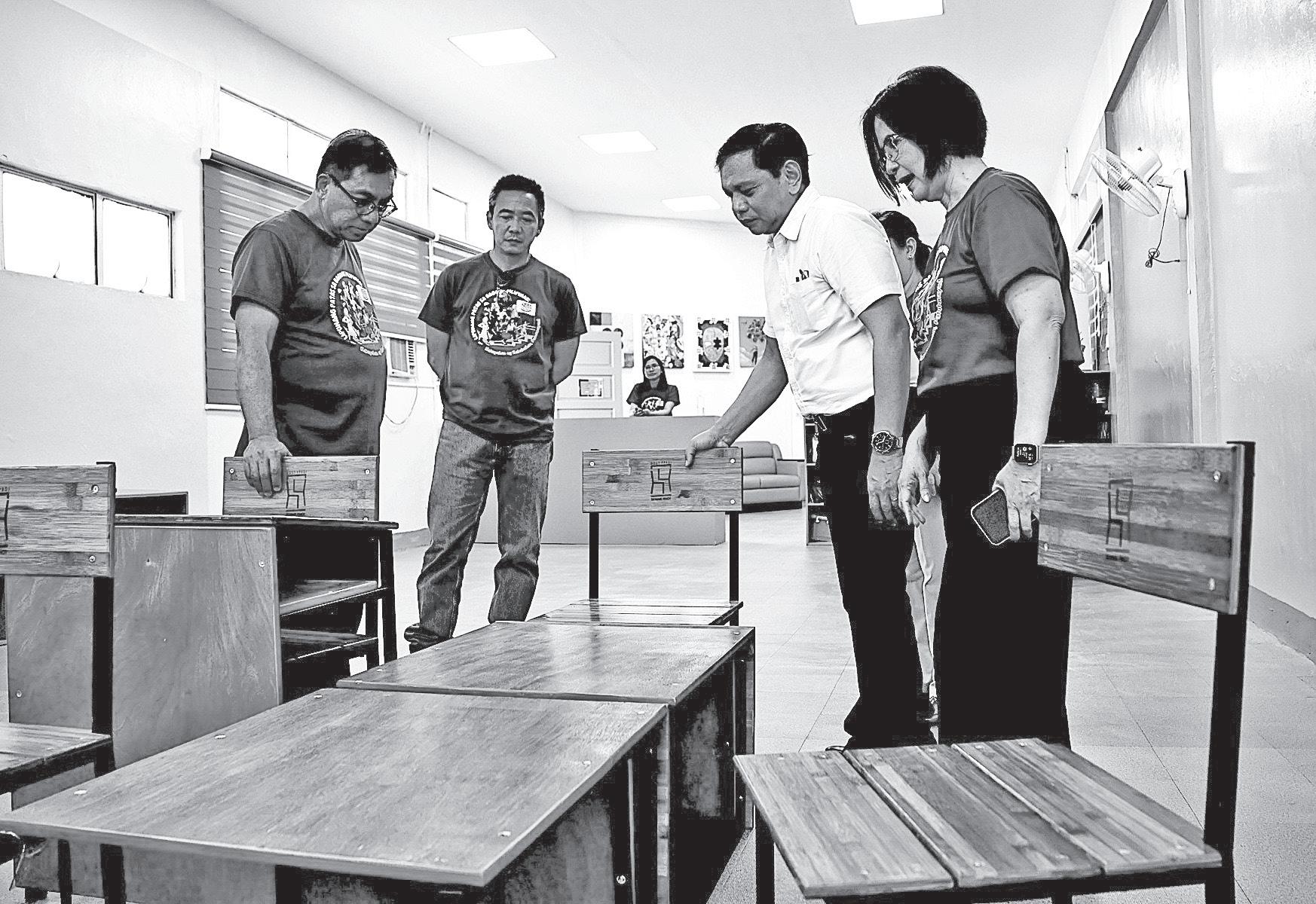
for a set of table and chair for elementary schools is at P2,500.
In contrast, the Silyang Pinoy prototype is priced at P1,955.95, or P544.05 lower than the DepEd price.
A one-table, two-chairs set for elementary schools is priced at P4,800 under the DepEd bidding price. But this is available for only P3,911.90 with the Silyang Pinoy prototype, saving P888.10.
For secondary schools, a table and chair set costs P2,500 with the DepEd price, but is only P1,979.37 with the DOST-FPRDI prototype, or lower by P520.63.
Similarly, a one-table, two-chair set for secondary schools sees a reduction from P4,800 of the DepEd’s price to P3,958.74 of engineered bamboo
EXPERTS from the University of the Philippines Manila (UP Manila) have developed a Point-of-Care Testing (POCT) device that could detect selected New Psychoactive Substances (NPS), also known as designer drugs.
Urine samples are used in the E-ToxNPS device.
It allows preliminary detection of NPS, such as ketamine, synthetic cannabinoids, and synthetic cathinones, said a UP Manila news release..
Preliminary screening
E-Tox-NPS supports public health by allowing preliminary screening of new psychoactive substances that is crucial in saving lives and timely clinical care to drug-related emergencies, the news release said.
The United Nations Office on Drugs and Crime (UNODC) defines NPS as “substances of abuse, either in a pure form or a preparation, that are not controlled by
the 1961 Single Convention on Narcotic Drugs, or the 1971 Convention on Psychotropic Substances, which may pose a public health threat.”
UNODC warns that the NPS that are available in the market have similar effects as substances under international control—such as cannabis, cocaine, heroin, LSD, ecstasy, and methamphetamine.
No screening kit for NPS in PHI
“THE E-Tox-NPS would be very useful because there is no POCT screening kit for NPS available for use in the Philippines,” said Dr. Ailyn M. Yabes, lead scientist/inventor, and associate professor at the Department of Pharmacology and Toxicology at UP Manila College of Medicine, and analytical toxicology consultant of the UP-Philippine General Hospital National Poison Management and Control Center.
“NPS is also not yet included in the drugs of abuse panel in the Philippines. Local
screening tests are limited to traditional illicit drugs. such as amphetamine and cannabinoids,” Yabes added. She explained that the ETox-NPS screening test is an initial test to check for the presence of NPS. It would still require a more specific and sensitive method to confirm the presence of NPS in the urine.
Device for non-accidental poisoning YABES ’s team also developed another device that could detect non-accidental poisoning from selected pharmaceutical drugs allowing for timely and more effective emergency care for the patient.
The E-Tox Phx POCT device detects poisoning from paracetamols, isoniazid and salicylate (aspirin poisoning), UP Manila said.
It also has a potential for test menu expansion to include other pharmaceuticals commonly associated with poisoning.
It should be noted that the existing screening platforms for NPS and pharmaceuticals are often lab-based, costly, and require hazardous chemicals, making them inaccessible and impractical for emergencies.
User-friendly
IN contrast, the E-Tox NPS and the E-Tox Phx POCT devices are portable, user-friendly, and cost-effective, allowing for a quicker diagnosis.
Both models have undergone analytical validation and demonstrated acceptable performance characteristics in terms of limit of detection, accuracy, precision, sensitivity, specificity, and predictive values according to industry standards.
The research team is ready to accept business partners for the manufacturing and commercial distribution of the E-Tox POCT and E-Tox-NPS devices, UP Manila said.
CLARK, Pampanga—Nuclear energy has long been associated with danger and catastrophic accidents, but this misconception was dispelled during the first-ever International Nuclear Science Olympiad (INSO) on Thursday as experts discussed its applications in agricultural, medicine, environmental protection, and energy grid stability.
According to Science Secretary Renato Solidum Jr., it is important for people to understand the diverse applications of nuclear energy. He explained that it can improve agriculture by helping with crop development and food safety, assist in medical diagnostics and treatments, support industrial tasks like checking container quality, and contribute to environmental efforts such as reducing plastic waste.
“There are many other applications that need to be discovered using nuclear technology,” he said.
Solidum emphasized that nuclear technology should be used to enhance human well-being, support the country’s economic growth, and contribute to environmental preservation and conservation.
Director Carlo Arcila, of the Philippine Nuclear Research Institute the first chair -
man of INSO, acknowledged that while the initial application of nuclear technology was for warfare, he highlighted the pioneering work of Admiral Hyman Rickover. Rickover developed the first “peaceful nuclear reactor for submarines,” exemplified by the successful operation of the USS Nautilus.
This nuclear-powered submarine demonstrated the potential of nuclear energy as a powerful and reliable source of propulsion.
Unlike diesel-electric submarines that relied on fossil fuels and emitted pollutants, the USS Nautilus had a smaller environmental footprint.
Arcila believed this helped change public perception, showing that nuclear technology could be harnessed for peaceful purposes beyond military applications.
“We have to help the world reduce its carbon emissions and provide electricity, and that is where nuclear power comes in,” he said.
He expressed hope that the youth from 14 countries across the Asia-Pacific region participating in the INSO competition “will recognize the peaceful aspects of nuclear technology that can benefit the world.”
“This initiative is crucial as it starts with
educating the youth, who can then inform their parents. Most of the opposition comes from parents,” he said.
He explained that some parents discourage their children from pursuing an interest in nuclear science due to perceived dangers, without understanding its diverse applications, as highlighted by the department secretary.
First INSO
THE six-day inaugural INSO started on August 1 in Clark, Pampanga. It is hosted by the Philippines and organized by the Department of Science and Technology (DOST) in collaboration with the Department of Education (DepEd), the DOSTNational Research Council of the Philippines (NRCP), and the Philippine Nuclear Science Foundation (PNSF).
Key partners included Meralco, Aboitiz, and E-Beam.
With support from the DOST-Philippine Nuclear Research Institute (PNRI), the event brought together junior and secondary students from Bahrain, Iran, Jordan, Malaysia, Oman, Qatar, Saudi Arabia, Singapore, Sri Lanka, Thailand, the United Arab Emirates, Indonesia, and the Philippines. Japan and Syria participated as observers.
“The Olympiad not only celebrates our achievements but also challenges us to push the boundaries of what is possible,” Solidum said.
The Philippine Science Chief emphasized the critical importance of nurturing young minds who will lead the future of nuclear science, highlighting the pivotal role of atomic energy in promoting peace and development.
He noted that advancements in nuclear technology can significantly contribute to achieving several of the United Nations Sustainable Development Goals (SDGs).
“To the participants, I commend your dedication and intellectual curiosity. Your presence here today is a testament to your commitment to advancing nuclear science for the betterment of humanity,” Solidum said.
He likewise urged the participants to seize every opportunity during the competition week to learn, grow, and build connections that will last a lifetime.
Meanwhile, Isaiah Taylor, Valor Atomics founder and CEO, encouraged the participants to keep advancing their skills in the field.
He highlighted that their collective growth could lead to transforming their
set, saving P841.26. The cost reductions in the engineered bamboo prototype’s pricing model is at its actual labor and material costs.
The DOST-FPRDI’s initiative aims to provide DepEd with more sustainable and economically viable options in furnishing schools across the country, ensuring better allocation of educational funds while maintaining the quality and durability of school furniture.
“It [Silyang Pinoy] is highly sustainable due to its primary component, bamboo,” Marasigan said.
He noted that bamboo, a rapidly growing grass, is one of the most significant non-timber forest products worldwide.
According to the DOST-Philippine Council for Agriculture, Aquatic and Natural Resources Research and Development, the Philippines ranks 6th globally in bamboo exports, with bamboo stands covering between 39,000 hectares and 53,000 hectares.
These bamboo stands are primarily found growing naturally in patches, backyards, riverbanks, and occasionally in private lands, although commercial stands are rare.
The estimated potential production from these bamboo areas is about 36 million culms per year.
“This technology is promising in terms of sustainability because we have plenty of bamboos,” Marasigan said partly in Filipino. When asked about the potential impact if both public and private educational institutions adopt the engineered bamboo school desks and chairs, Marasigan explained that such a shift could significantly boost the bamboo industry.
He said that increased demand would lead to higher bamboo production, which would encourage farmers to continue cultivating bamboo and empower local communities through initiatives like Silyang Pinoy.
“At the same time our country will become climate resilient because bamboo has that added function,” he added.
As of this writing, the engineered prototype school chairs are being distributed in Apayao, Palawan, and Camiguin.
Agri innovation grants open to Filipinos, Southeast Asians
AGRICULTURAL innovators and researchers in Southeast Asia now have a chance to submit proposals for their research projects.
The Southeast Asian Regional Center for Graduate Study and Research in Agriculture (Searca) is accepting proposals for its Grants for Research towards Agricultural Innovative Solutions (GRAINS) until August 9.
Searca GRAINS offers substantial funding to support research projects addressing critical agricultural challenges. They include developing sustainable farming practices, building climateresilient agriculture, advancing agricultural biotechnology, strengthening value chains, ensuring food security, and creating effective agricultural policies.
Dr. Glenn Gregorio, Searca Center Director, said: “Through GRAINS, we aim to empower researchers and innovators to develop solutions that will lead to a more sustainable and resilient agricultural sector in Southeast Asia.” Innovators and researchers from the academe, government agencies, nonprofit organizations, and the private sector across Southeast Asia are encouraged to apply. Successful applicants will receive funding to conduct research for up to one year. The Searca GRAINS grant covers various research expenses, including personnel costs, equipment, fieldwork, and knowledge dissemination activities. Proposals must demonstrate a clear focus on innovative agricultural solutions with the potential to significantly impact the region. Searca prioritizes proposals that are aligned with its mission of Accelerating Transformation Through Agricultural Innovation. Gregorio affirms that “Innovation is at the heart of Searca’s mission. Searca is looking for projects that not only push the boundaries of agricultural research but also have the potential to create meaningful change for farmers and communities across Southeast Asia.”
Applications must be submitted electronically through the GRAINS Information System at https://grains.searcaapps.org/
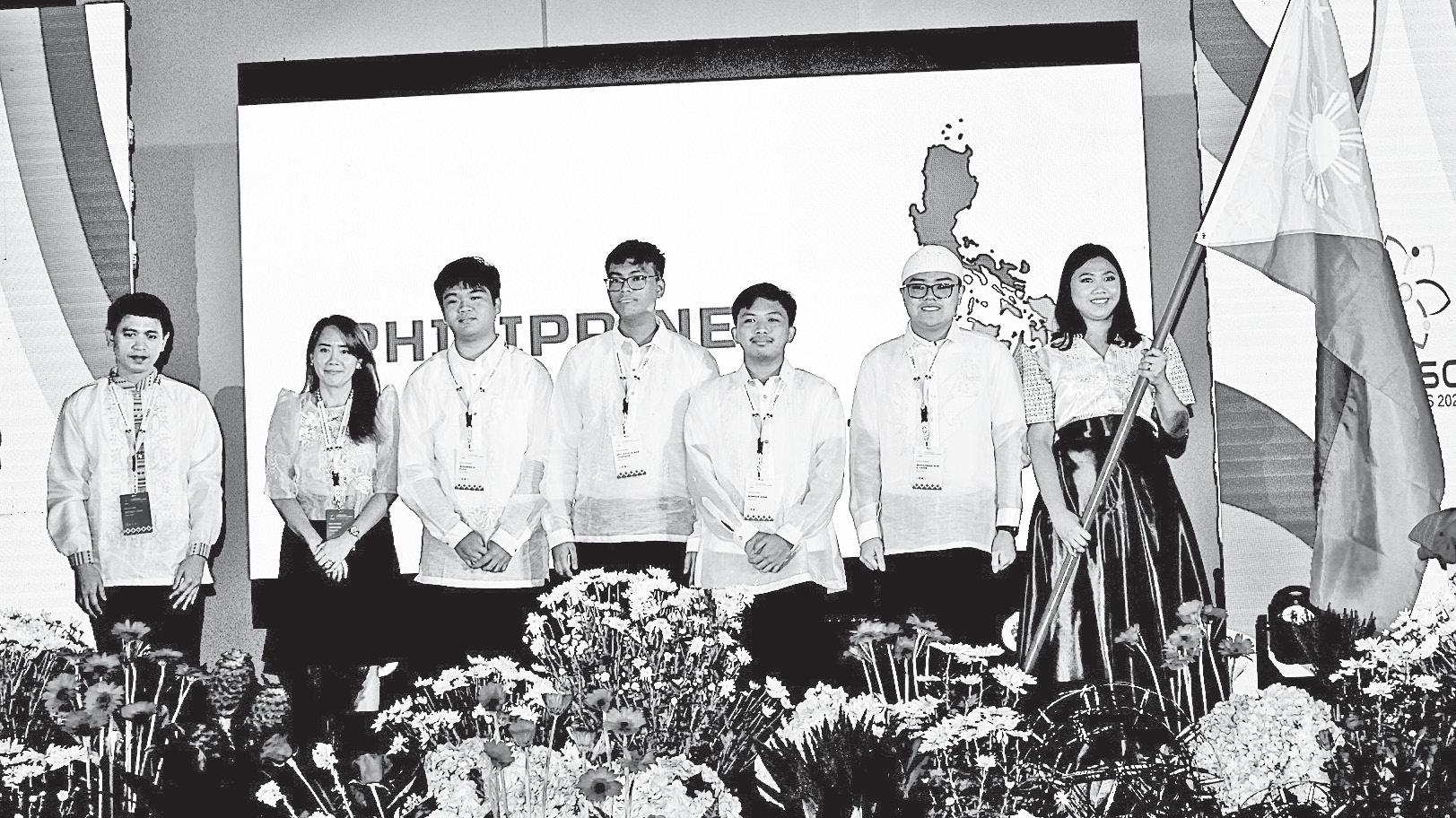
countries into independent sources of
and industry.
“The nuclear industry has seen good times and bad times with the fact that you’re eager to learn and prove your skills to show that nuclear power is the power source of the future,” he said.
He pointed oit that many of the partici
He emphasized that their
if
bolstering sustainability efforts. This involves conserving natural resources and sustaining the scientific community’s achievements to secure long-term national gains. John Eiron R. Francisco
A6 Sunday, August 4, 2024
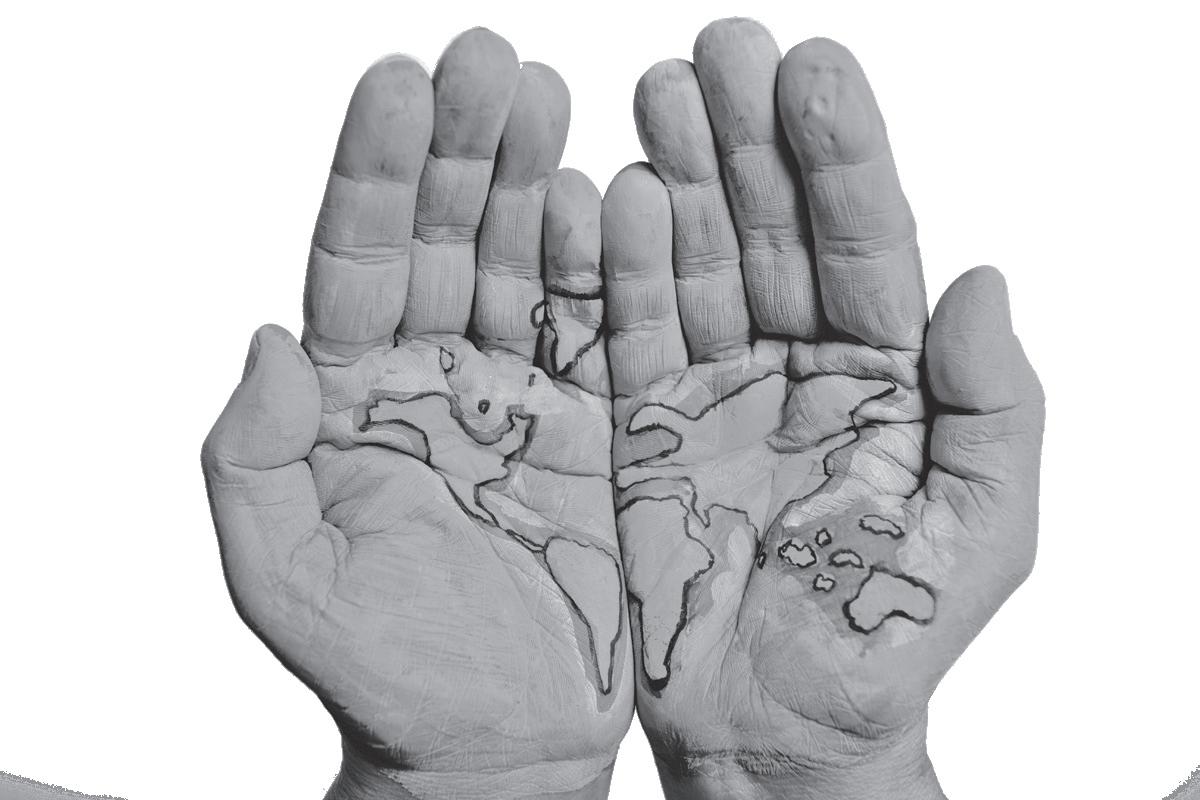
N an emotional homily, a top Catholic Church official urged priests to pay attention to what ordinary faithful have to say and reach out to those who have often been overlooked in parishes.
At the opening Mass for a meeting of parish priests from across the country in Manila, Cardinal Jose Advincula called for a departure from “our tombs of exclusivity and comfort” to foster genuine communion within the Church.
Advincula celebrated the Mass at the “National Meeting of Parish Priests for the Synod” that brought together over 250 priests from various dioceses to discern ways to rejuvenate their priesthood and parish life.
The cardinal emphasized that true communion cannot be achieved if the clergy cling to “outdated conventions and unhealthy conveniences.”
“If we keep saying we have been doing it this way, we might be unconsciously pushing away the people who need our communion the most, people who often feel that they cannot fit in the Church, the sinners, the poor, the marginalized,” Advincula said.
The cardinal, who is the archbishop of Manila, cautioned against acts that “discount or
even suppress” the contributions of parishioners, urging priests to avoid making people “sheepishly dependent” on clergy.
Instead, he called for allowing ordinary Catholics, especially the marginalized, to express their sentiments and insights, which he believes is essential for true synodality in parish communities.
“Let us recognize and encourage their boldness as witnesses to our faith,” Advincula said.
“Let us include such voices and contributions in the life of our parish communities,” he added.
His voice faltered as he urged priests not to succumb to “factions,” claiming the Church is dead or dying, asserting that recent synodal consultations have shown that the Church is indeed alive.
He noted that the Church’s vitality is evident in the laypeople, servant leaders, and consecrated individuals who are devoted to God and close to the people.
“The church may appear to be sleeping or having some difficulty waking up but definitely she is not
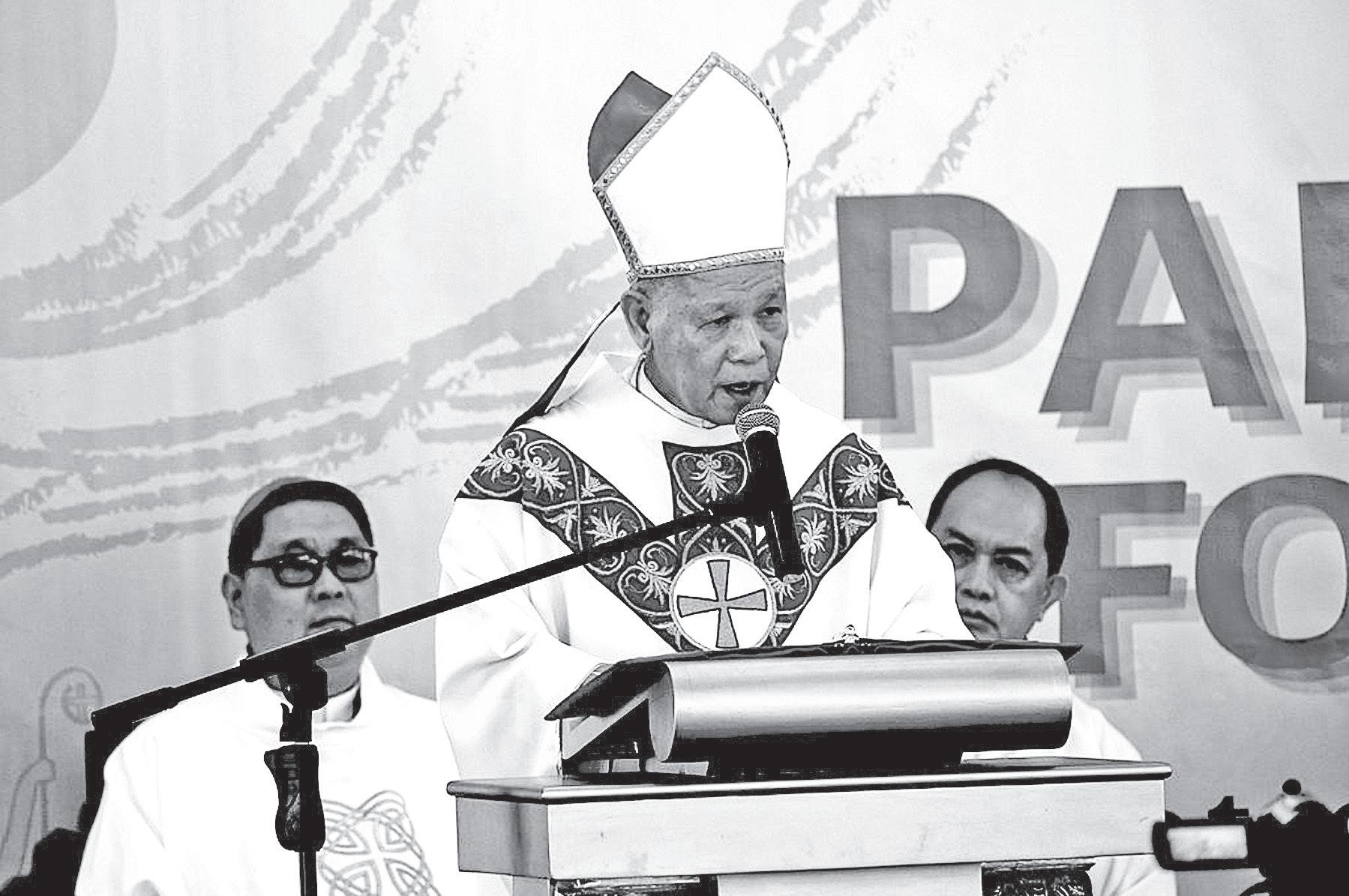
dead. The church is very much alive,” the cardinal said.
“She is especially alive in our beloved poor who touch us and challenge us with their simple yet genuine faith. She is alive not because we are able to keep it alive, but because God is merciful and faithful to us,” he added.
The participants to the meeting of parish priests in the past week were selected by their bishops to represent a range of experiences and environments.
Organized by the bishops’ conference and the Office for the Promotion of New Evangelization (OPNE), the four-day gathering follows the Vatican-organized international meeting of parish priests held in Sacrofano, Italy, from April 29 to May 1.
Fr. Jayson Laguerta, OPNE di -

WITH the Paris Olympic Games underway, 120 chaplains from five different religions are present in the Multifaith Center tent located in the athletes village to address the spiritual needs of the thousands of athletes set to compete. The center, which remains open until the end of the Paralympic Games on September 8, includes a reception area and five rooms pertaining to each of the represented religions— Christianity (Catholics, Orthodox, and Protestants), Judaism, Hinduism, Buddhism, and Islam—in accordance with the International Olympic Committee (IOC).
The athletes have the opportunity to pray, attend religious services, and speak with chaplains daily on a variety
of topics, including concerns over mental health, losing competitions, and ongoing global conflicts.
According to the Associated Press, organizers found that requests for Olympic chaplains exceeded 8,000 during the prepandemic games.
Fr. Jason Nioka, a former judo champion-turned priest in charge of the 40 Catholic priests, nuns, and laypeople participating in this group, shared with the AP that the chaplains “need to bring [the athletes] back to earth, because it can feel like the end of the world after working on this goal for four of five years.”
Echoing this sentiment was Fr. Xavier Ernst, the parish priest of the Church of St. John Bosco in the 20th arrondissement of Paris.
In an ANS article, Ernst shared that the chaplains’ “service is to be present. Athletes know that in the Olympic Village there is this space, a place for listening, sharing and relationship. Our environment is furnished with icons, symbolic furnishings, and the Bible.”
“Every morning there will be a moment of lectio divina, of reading and sharing the Gospel, a moment that will be ecumenical,” he said.
“Every day we will celebrate the Eucharist, not in the multireligious center but in the church next to the village.”
At the nearby Cathedral of Saint-Denis, a vigil Mass took place in which prayers for a blessing of the athletes and a distribution of Miraculous Medals took place on July 25, the night before the opening
rector and one of the 10 Filipino delegates to the international event, said the Manila gathering is a response to Pope Francis’s call to continue the synodal conversation.
Pope Francis has underscored the vital role of parish priests in the synodal process, asserting that without their commitment, a truly synodal Church cannot be realized.
Laguerta expressed hopes that the gathering would inspire priests to embrace a more communal and participatory leadership style and strengthen the unity among the clergy, setting an example for laypeople to follow.
“We hope to inspire them to be more communal and participatory in their leadership. And so we would like to introduce and
ceremony.
Similarly, the downtown Paris church La Madeleine provides participants and athletes a place of prayer and contemplation throughout the Olympic Games with its special chapel dedicated to “Our Lady of Athletes.”
Inaugurated in September 2023, this space allows for visitors to light candles, submit prayer intentions, and seek spiritual support.
La Madeleine was also the location for a solemn Mass celebrated on July 19 to commence the Olympic Truce, a period of peace that traditionally calls for the end of conflicts between world countries during the Olympics.
Archbishop Laurent Ulrich of Paris, a special representative of the Holy See for the 2024 Paris Olympics, emphasized during his homily that “ongoing wars do not cease during the games, but the desire for peace spreads through the encounters they make possible in these sporting events.”
Amid the various events and the presence of Catholic chaplains within the Multifaith Center is the Vatican’s Holy Games, an ongoing initiative intended to call people toward holiness through sport.
Following the recitation of the Angelus on July 21, Pope Francis spoke of sports having a “great social power” and the ability to “peacefully unite people from different cultures.”
“I hope that this event may be a beacon of the inclusive world we want to build and that athletes, with their sporting testimony, may be messengers of peace and authentic models for young people,” the Holy Father said.
“In particular, as is the custom of this ancient tradition, may the Olympic Games be an occasion to call for a cease-fire in wars, demonstrating a sincere desire for peace.” Gigi
promote the conversation in the spirit as a synodal methodology,” Laguerta said.
“We also hope that this gathering could strengthen the brotherhood of priests because we need to show first that we are synodal so that the lay people that we serve will also be given the cue to be synodal,” he added.
‘Synodality is empowering others’
MEANWHILE , in parishes where there is growing diversity, the head of the Philippines’ Catholic episcopal conference said synodality helps people realize that “the mission is about the Church.”
Speaking at a meeting of the parish priests, Bishop Pablo Virgilio David highlighted the importance of shared responsibility within the Church.
He said that many priests may be “in a state of burnout,” partly because they operate within a “clericalism paradigm” where all the burdens fall on them.
“And it is so unnecessary,” David said. “That’s why synodality brings in the wisdom of not monopolizing the mission.”
While ordained ministers have a specific role in the mission, the bishop stressed that empowering the laity reflects a significant shift toward a more collaborative and sustainable approach in Church ministry.
“The burden becomes much lighter when, precisely, we are able to empower our laity to participate
meaningfully and effectively in the life and mission of the Church,” David added.
The national meeting explores some themes from the synthesis report of the first session of the Synod on Synodality in October 2023 in Rome.
It aims to, among others, to learn to practice the art of communal discernment and to foster communion and participation among priests and bishops.
Among the speakers is Xavière Missionary Sister Nathalie Becquart, undersecretary of the General Secretariat of the Synod of Bishops on Synodality.
During his January visit to Manila, the Vatican’s synod chief described synodality as a “gift” for priests and bishops in their mission.
Cardinal Mario Grech, general secretary of the Synod of Bishops, explained that it offers a way for priests to collaborate and not feel isolated in their responsibilities.
“Synodality reminds us we are not alone—make space for others, walk with them, and listen,” Grech said during the Philippine Conference on New Evangelization meeting.
The archbishop believes that embracing synodality can help priests experience their vocation more joyfully.
“We have to respect the ministries and charisms of each other. We can learn from one another,” Grech also said. Roy Lagarde

‘POLITICS is one of the highest forms of charity because it seeks the common good,” says Pope Francis, quoting his predecessor St Paul VI.
In his prayer intention for the month of August, the Holy Father invites the faithful to join him in prayer “that political leaders be at the service of their own people, working for integral human development and the common good, taking care of those who have lost their jobs and giving priority to the poorest.”
In his video message announcing this month’s intention, Pope Francis acknowledges that “politics does not have a very good reputation.”
Nonetheless, he says, politics properly so-called—as opposed to “politicking”—“listens to what is really going on…is at the service of the poor…is concerned for the unemployed.”
“If we look at it in this way,” the pope says, “politics is much more noble than it appears.”
So, he says, as we pray for political leaders, we should also be grateful “for the many politicians
who carry out their duties with a will to serve, not of power, who put all their efforts toward the common good.”
Why pray for political leaders?
COMMENTING on the Pope’s prayer intention for August, the international director of the Pope’s Worldwide Prayer Network, Fr Frédéric Fornos, SJ, voices the objection, “Why pray for political leaders?”
However, he says, “political leaders are who we make of them. Instead of fuelling contempt for them with our words and our thoughts, let’s help them to be the men and women we would like them to be. Let’s pray for them, as Pope Francis invites us to do.” Fornos recalls that, although at times politicians can be greedy or power-hungry, there are many political leaders “who truly serve the common good.” For our part, Fornos asks rhetorically, “What are we doing? What would we do in their place?” And he answers, “The
pray for them.”

Editor: Lyn Resurreccion

FROM lowly rocks, a Balik Scientist developed a filter that can sift harmful chemicals in the air.
As of 2017, over 200 plastic and rubber manufacturing companies are operating in Valenzuela City.
Emissions coming from large factories and recycling plants are said to cause health concerns, particularly pulmonary problems, among residents nearby.
Dr. Ramuel John I. Tamargo, who had his postgraduate studies at the Yeugnam University in South Korea, developed an air filter that can absorb volatile organic
compounds and other harmful gases common in plastic manufacturing plants.
In his stint as a Balik Scientist, Tamargo developed “AirSaver,” or “Air Purification using Sustainable Aluminosilicate for Valenzuela Environmental Remediation.”
He envisions to improve the lives of residents around industrial areas.
Science Secretary Dr. Renato U. Solidum Jr. expressed hope

that the air filter will be used by industries to improve the health of their workers as well as the
communities.
“We look forward to the day that these air filters will be ubiquitous
WHEN wildfire smoke is in the air, doctors urge people to stay indoors to avoid breathing in harmful particles and gases.
But what happens to trees and other plants that can’t escape from the smoke?
They respond a bit like us, it turns out: Some trees essentially shut their windows and doors and hold their breath.
As atmospheric and chemical scientists, we study the air quality and ecological effects of wildfire smoke and other pollutants.
In a study that started quite by accident when smoke overwhelmed our research site in Colorado, we were able to watch in real time how the leaves of living pine trees responded.
How plants breathe PLANTS have pores on the surface of their leaves called stomata. These pores are much like our mouths, except that while we inhale oxygen and exhale carbon dioxide, plants inhale carbon dioxide and exhale oxygen.
Both humans and plants inhale other chemicals in the air around them and exhale chemicals produced inside them—coffee breath for some people, pine scents for some trees.
Unlike humans, however, leaves breathe in and out at the same time, constantly taking in and releasing atmospheric gases.
Clues from over a century of research
IN the early 1900s, scientists studying trees in heavily polluted areas discovered that those chronically exposed to pollution from coal-burning had black granules clogging the leaf pores through which plants breathe.
They suspected that the substance in these granules was partly created by the trees, but due to the lack of available instruments at the time, the chemistry of those granules was never explored, nor were the effects on the plants’ photosynthesis.
Most modern research into wildfire smoke’s effects has focused on crops, and the results have been conflicting.
For example, a study of multiple crop and wetland sites in California showed that smoke scatters light in a way that made plants more efficient at photosynthesis and growth.
However, a lab study in which

plants were exposed to artificial smoke found that plant productivity dropped during and after smoke exposure—though those plants did recover after a few hours.
There are other clues that wildfire smoke can impact plants in negative ways.
You may have even tasted one: When grapes are exposed to smoke, their wine can be tainted.
What makes smoke toxic, even far from the fire
WHEN wildfire smoke travels long distances, the smoke cooks in sunlight and chemically changes.
Mixing volatile organic compounds, nitrogen oxides and sunlight will make ground-level ozone, which can cause breathing problems in humans.
It can also damage plants by degrading the leaf surface, oxidizing plant tissue and slowing photosynthesis.
While scientists usually think about urban regions as being large sources of ozone that effect crops downwind,
wildfire smoke is an emerging concern.
Other compounds, including nitrogen oxides, can also harm plants and reduce photosynthesis.
Taken together, studies suggest that wildfire smoke interacts with plants, but in poorly understood ways.
This lack of research is driven by the fact that studying smoke effects on the leaves of living plants in the wild is hard: Wildfires are hard to predict, and it can be unsafe to be in smoky conditions.
Accidental research
—in the middle of a wildfire
WE didn’t set out to study plant responses to wildfire smoke.
Instead, we were trying to understand how plants emit volatile organic compounds— the chemicals that make forests smell like a forest, but also impact air quality and can even change clouds.
Fall 2020 was a bad season for wildfires in the western US, and thick smoke came through a field site where we
were working in the Rocky Mountains of Colorado.
On the first morning of heavy smoke, we did our usual test to measure leaf-level photosynthesis of Ponderosa pines.
We were surprised to discover that the tree’s pores were completely closed and photosynthesis was nearly zero.
We also measured the leaves’ emissions of their usual volatile organic compounds and found very low readings.
This meant that the leaves weren’t “breathing”—they weren’t inhaling the carbon dioxide they need to grow and weren’t exhaling the chemicals they usually release.
With these unexpected results, we decided to try to force photosynthesis and see if we could “defibrillate” the leaf into its normal rhythm.
By changing the leaf’s temperature and humidity, we cleared the leaf’s “airways” and saw a sudden improvement in photosynthesis and a burst of volatile organic compounds.
What our months of data told us is that some plants respond to heavy bouts of wildfire smoke by shutting down their exchange with outside air.
They are effectively holding their breath, but not before they have been exposed to the smoke.
We hypothesize a few processes that could have caused leaves to close their pores:
n Smoke particles could coat the leaves, creating a layer that prevents the pores from opening.
n Smoke could also enter the leaves and clog their pores, keeping them sticky.
n Or the leaves could physically respond to the first signs of smoke and close their pores before they get the worst of it.
It’s likely a combination of these and other responses.
The long-term impact still unknown
The jury is still out on exactly how long the effects of wildfire smoke last and how repeated smoke events will affect plants—including trees and crops—over the long term.
With wildfires increasing in severity and frequency due to climate change, forest management policies and human behavior, it’s important to gain a better understanding of the impact. Delphine Farmer, Colorado State University/ The Conversation (CC) via AP
in the operations of our manufacturing industry. We thank Dr. Tamargo for sharing his brilliant idea and bringing it into fruition,” Solidum said.
The air filter was developed under the Niche Center in the Regions for Research and Development Program in 2021. The project is being monitored by the Department of Science and Technology’s Philippine Council for Industry, Energy and Emerging Technology (DOST-PCIEERD).
AirSaver is developed from locally sourced natural zeolite, which can be found both in volcanic and sedimentary rocks.
It is commonly used to remove heavy metals and other pollutants from water. It also has other wide range of applications.
In his project, Tamargo used and developed the material into a fixed bed filter installed in plant industries’ exhaust system to filter air emissions. It targets volatile organic compounds and other harmful gases produced by plastic manufacturing plants in Valenzuela City.
DOST-PCIEERD Executive Director Dr. Enrico C. Paringit urged Filipino scientists to follow Tamargo’s example and help in infusing fresh ideas in the scientific community through the Balik Scientist Program.
“We hope more of our ‘kababayan’ follow suit and return to the Philippines to help our scientific community flourish. DOST is ready to open opportunities for our Balik Scientists,” he said.
Drug trafficking in Central America worsening deforestation, threatening birds
ACTIVITIES associated with cocaine trafficking threaten two-thirds of the most important landscapes in Central America for 196 forest bird species, including 67 migratory species.
This is the key takeaway from a study that colleagues and I published in June 2024 in the journal Nature Sustainability.
The findings suggest that there is real potential for drug-related deforestation to negatively affect populations of migratory birds.
Many of the species are unusually concentrated in winter in Central America, which has a comparatively smaller area than their summer breeding regions in North America.
For 1 in 5 migratory species that travel to Central American forests annually, including familiar birds like the Baltimore oriole, more than 50 percent of their global population winters in areas that are becoming more attractive to traffickers.
For half of migratory species, at least 25 percent of their populations winter in these areas.
As examples, an estimated 90 percent of the endangered golden-cheeked warbler population spends winters in these vulnerable landscapes, along with 70 percent of Philadelphia vireos and 70 percent of golden-winged warblers.
Why it matters
NEARLY half of Earth’s migratory bird species are declining, and 1 in 5 species are at risk of extinction.
Since 1970, North America alone has lost 3 billion breeding birds – more than 25 percent of its total population.
Birds perform many important ecological roles, including eating insects, pollinating plants and dispersing seeds, and their presence often is a reliable measure of the overall health of an ecosystem.
The illicit drug trade is a major driver of forest loss in Central America.
Drug traffickers cut down tropical forests to create landing strips and roads, and to establish farms and ranches.
They use these businesses to launder their profits into the legal economy.
These activities, in turn, often lead to further forest loss, development and criminal activities.
In some Central American countries, so-called narco-deforestation is estimated to account for nearly one-third of all deforestation.
A growing body of evidence suggests that current drug policies and interdiction strategies, which focus almost exclusively on
drug suppliers, are making “narcodeforestation” worse.
Traffickers may respond to interdiction efforts by shifting activities to more remote and intact forested areas—zones that are especially important for wildlife.
Indeed, one recent study showed that US-led interdiction efforts within the Mesoamerican Biological Corridor—a patchwork of protected areas that runs from Mexico to Panama—pushed traffickers into zones with the highest densities of jaguars in Central America.
How we did our work
MORE than 1 million birdwatchers have submitted data to eBird, a global participatory science initiative that collects observations to document bird distribution, abundance, habitat use and trends. This information helps scientists understand in detail how numbers of birds in particular locations change through the year, and to diagnose and mitigate key threats to bird populations. In our study, we combined eBird data on bird abundance and distribution with previously published information on changes in the likelihood that landscapes would experience cocaine trafficking in the future.
We summarized these changes as a measure of “suitability” for drug-related activities. Suitability, in this case, was estimated from social and environmental features that have been shown to be attractive to narco traffickers.
For example, areas that are forested, far from roads and sparsely populated are more likely to conceal activities than heavily used areas near towns.
What’s next
OUR study adds to existing evidence that drug interdiction efforts may push trafficking activities into increasingly remote and forested areas, many of which provide important habitat for migrating birds.
Narco-trafficking is just one reminder that the futures of humans and nature are tightly intertwined.
To avert negative consequences for people and nature, governments could consider expanding or strengthening measures to help local communities monitor and protect their land.
Research shows that community control often is an effective way to conserve natural areas, reduce poverty and protect wildlife.
By Jun Lomibao
PARIS—I’m in Paris and to simply describe the city as beautiful and captivating would not quite capture what the French capital really is—center for arts, gastronomy, culture and fashion or a city that gives the true meaning of melting pot.
I prefer not to accept Paris as the City of Love.

I’m here to cover the Summer Olympic Games, second time for Paris as host in a hundred years and for the Philippines, a centennial celebration of its participation in the quadrennial games.
It’s also the fifth consecutive Olympics that the BusinessMirror is covering the world’s most spectacular sporting event—as I see it, feel it and taste it, a privilege and personal pride that I had the five rings tattooed on my left wrist.
The trip to Paris was long but not a tedious one—22 hours with a three-hour layover in Jeddah from the Ninoy Aquino International Airport to the Charles de Gaulle—on board Saudia, which, to my surprise, served sumptuous Binagoongang chicken. Man, it was good.
Just like in Beijing in 2008 when Hidilyn Diaz was a nobody, then London 2012 when Diaz crashed out with a “No “Lift,” Rio de Janeiro when she got silver and lastly in Tokyo 2020 (2021 actually, no thanks to the pandemic) when she got gold for the country’s first in the Olympics—the routine was to have my accreditation card validated, check in the hotel, get some rest and head for the Main Press Center (MPC) to immediately get embedded in the task ahead.
In all those coverages—including non-Olympic events like the Asian Games, Southeast Asian Games, FIFA World Cup and a few world and
regional championships here and there, I always get to see and meet Filipinos who call their new countries their homes.
But surprise of all surprises, I met someone in Paris who doesn’t have a single drop of Filipino blood in her veins, but she’s very Filipino in name.
“Hello...Philippines?” she asked me and my colleagues— Philippine Star’s Nelson Beltran and Manila Bulletin/Tempo’s Rey Lachica—as she offered her right hand. “I’m Philippine.”
She’s Philippine Leprince, a member of the Media Operations Team for the Olympics, who said it was her dad who picked the name Philippine.
Too bad we only had that very brief interaction at the MPC Main Help Desk because while I was preoccupied with signing up for the Wifi, My Games and Transportation App, she was off for the day.
Fast forward to Friday, the 2nd of August, and the 22-athlete Philippine campaign was down to three (from five) boxers, one (from four) gymnast and still three in athletics.
By the time this issue comes out, gymnast
Carlos Yulo could have won the floor exercise gold medal; boxers Carlo Paalam, Aira Villegas or Nesthy Petecio could have either remained on track for the gold medals or have exited; and Ernest John “EJ” Obiena could have earned or missed a berth in the pole vault final.
There’s still so much task to accomplish ahead that visiting numerous landmarks isn’t high in the order of priorities—lest the consequences from the bosses.
And endurance and versatility play a major role in this “hot today-rainy tomorrow-repeat” French weather and not to forget the time zone—six hours behind that beating deadlines feels like catching Tadej Pojacar up the Pyrenees.
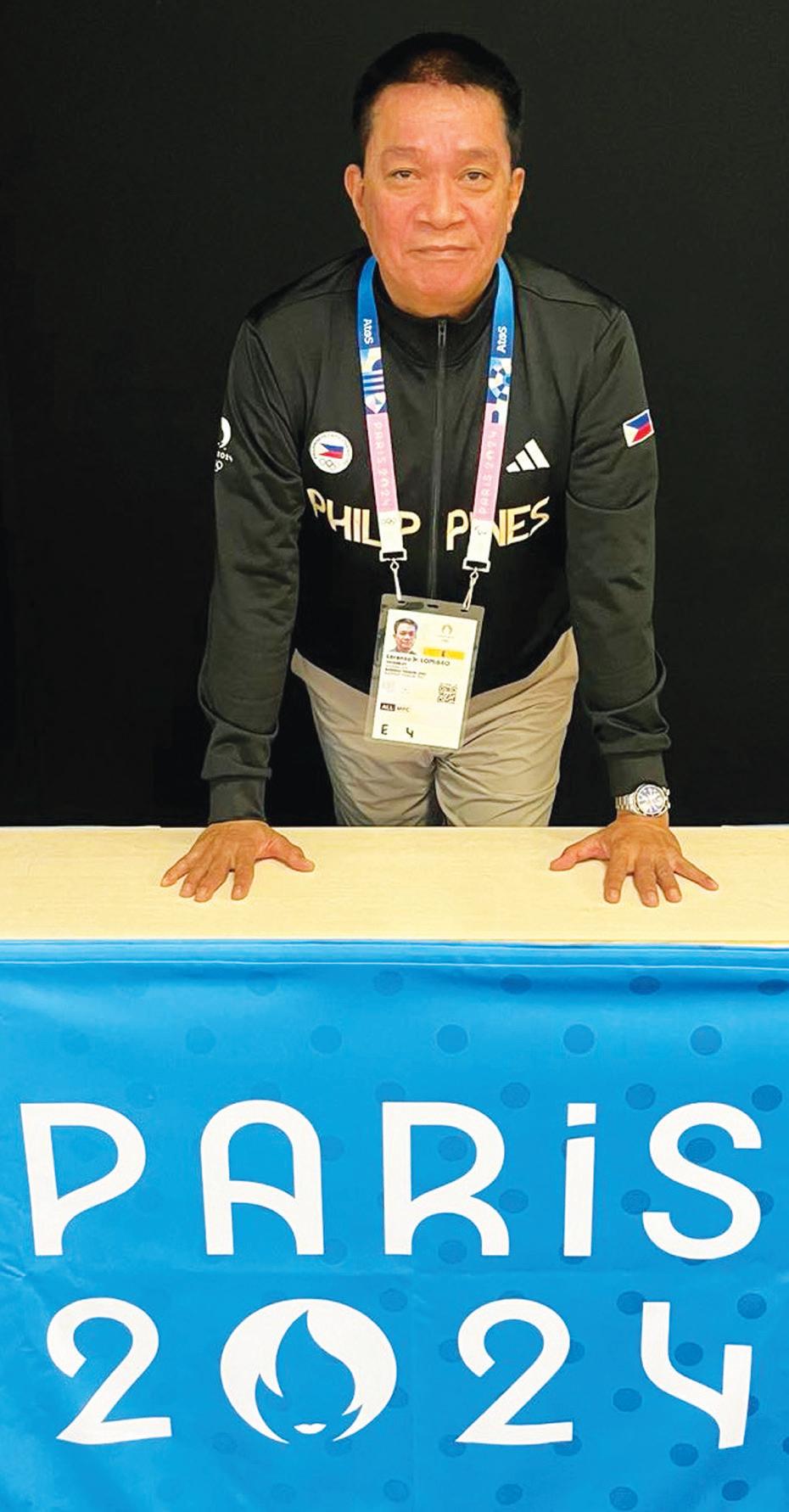
Discussions underway for inclusion of cross-country running, cyclocross in Winter Olympics program
PARIS—Talks to give crosscountry running and cyclocross Olympic status in the Winter Games have begun, World Athletics president Sebastian Coe said Thursday at the Paris Summer Games.
The two events could share a course for racing, Coe suggested, with the added goal of giving African nations that are strong in crosscountry a path into winter sports.
“It really does give Africa the opportunity to be a serious part of the Olympic Games,” he said at a news conference on the day track and field started in Paris. Olympics hosts can now ask to add their own favored events, and the 2030 Winter Games will be in the French Alps then the 2034 edition in Salt Lake City.
Coe revealed “tentative discussions” have started with the United States Olympic body and organizing officials from Utah.
With just 116 medal events at the 2026 Milan-Cortina d’Ampezzo Winter Games, there

Cross-country and cyclocross typically are raced on muddy and hilly courses that are traditional winter options for runners and riders. The current men’s world champion in cyclocross, Mathieu van der Poel, also stars in road cycling and was the 2023 worlds gold medalist.
Any formal proposal to insert the two new events into the Winter Olympics would have influential friends in the IOC.
Coe said he is working with International Cycling Union president David Lappartient, his fellow IOC member who also leads the French Olympic body and shaped its 2030 candidacy. Lappartient is seen as an increasingly close ally of Thomas Bach, the IOC’s hands-on president.
“David is very keen,” Coe said, adding “there is a lot of goodwill” for cross-country’s return to Olympic status more than 100 years after it was run at the 1924 Summer Games in Paris.
“Its obvious home is the winter,” Coe said.
The IOC reiterated Thursday the 2030 Olympics events program should be finalized before the end of 2027.
The Olympic body did not address questions about if it is currently considering a proposal to add crosscountry and cyclocross. AP
PARIS—Records are being broken daily at the 2024 Olympics, which run from July 27 to August 11, as athletes and teams win medals across 32 sports. Below is a list of all the world and Olympic records set at the Paris Games:
SHOOTING
ADRIANA RUANO of Guatemala
hit 45 of 50 targets in the women’s trap competition to break the Olympic record of 43 set by Rehak Stefecekova of Slovakia at the Tokyo Games in 2021. Nathan Hales of Britain scored a 48 in men’s trap, breaking the Olympic record of 43 set
pistol, breaking the Olympic record of 240.3 set by Vitalina Batsarashkina representing the Russian Olympic Committee at the Tokyo Games in 2021. Roommate Kim Yeji also surpassed the previous mark with her score of 241.3 and won the silver medal.
SWIMMING
SUMMER MCINTOSH of Canada swam the women’s 200-meter butterfly in 2:03.03, breaking the Olympic record of 2:03.86 set by China’s Zhang Yufei at the Tokyo Games in 2021.
Australia’s Mollie O’Callaghan, Lani Pallister, Brianna Throssell and Ariarne Titmus swam the women’s 4x200-meter relay in 7:38.08, breaking the Olympic
record of 7:40.33 set by China in 2021 at the Tokyo Games. Pan Zhanle of China swam the men’s 100-meter freestyle in 46.40 seconds to break his own world record of 46.80 from the world aquatics championship in February.
Léon Marchand of France broke two Olympic records set three years ago in Tokyo on the same night. He swam the men’s 200-meter butterfly in 1:51.21 to best the 1:51.25 time by Kristof Milak of Hungary, then two hours later completed the 200 breaststroke in 2:05.85 to eclipse the previous mark of 2:06.38 by Zac Stubblety-Cook of Australia.
Marchand swam the men’s 400-meter individual medley in 4:02.95, breaking the Olympic record of 4:03.84 set by Michael
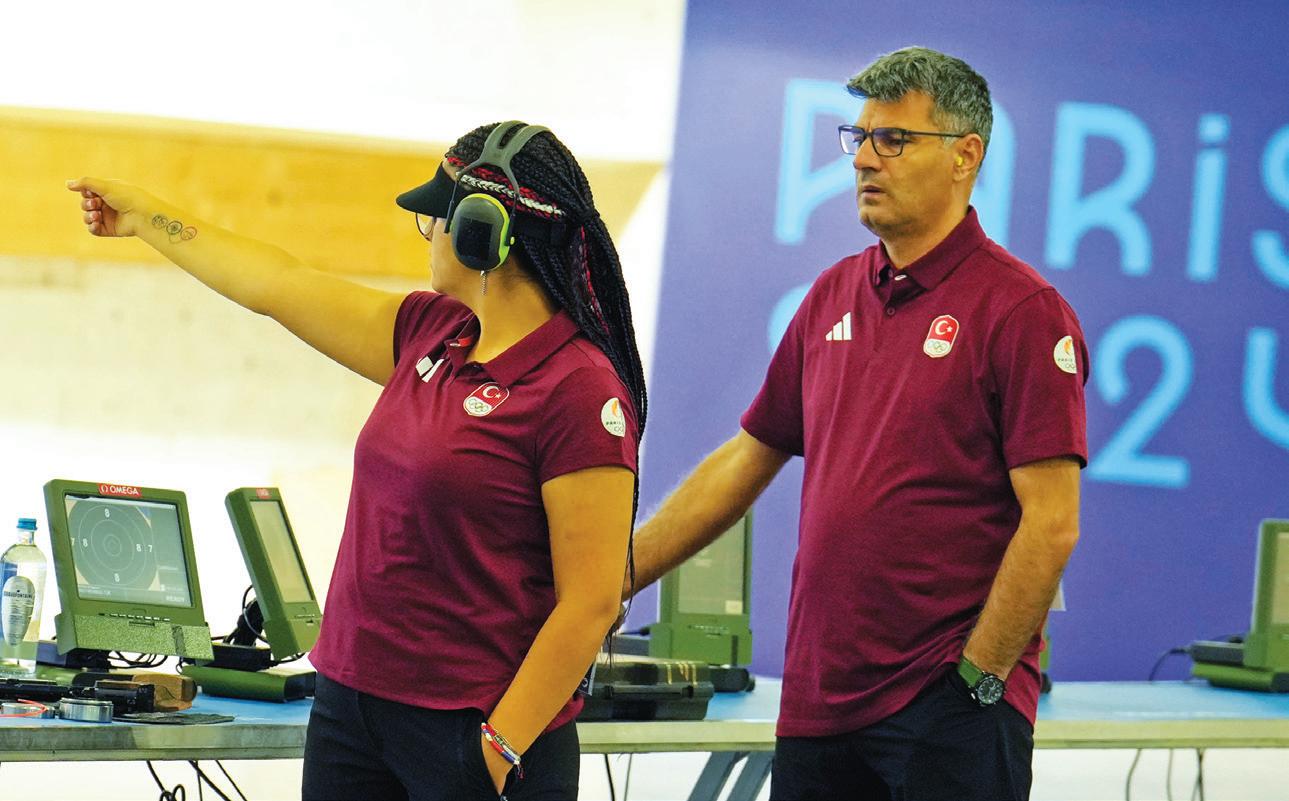
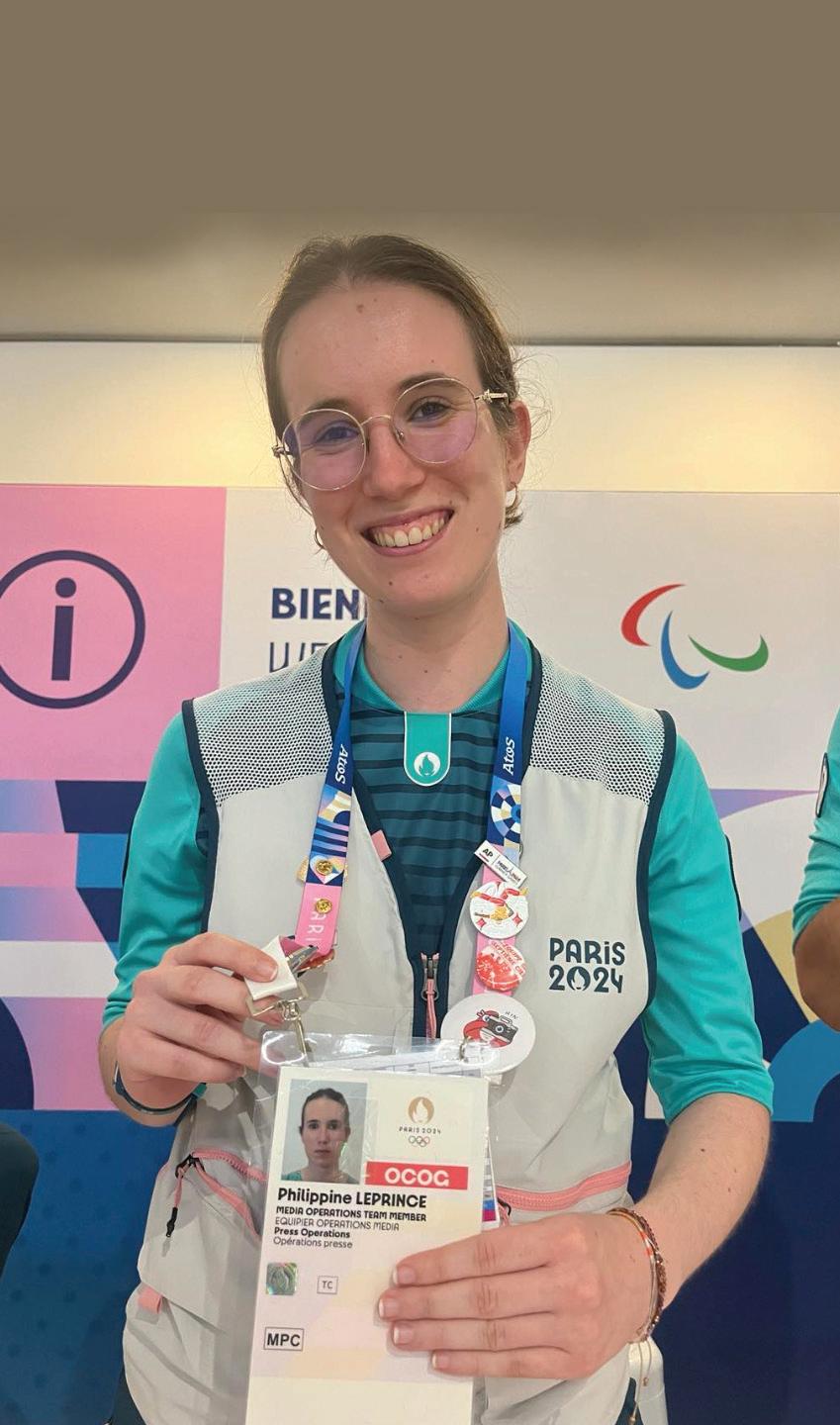
No Olympic medal for caddies? Schauffele gives Kaiser gold ring
SAINT-QUENTIN-EN-YVELINES, France—Caddies do not get a medal in the Olympics, only the golfers do. The caddie for Xander Schauffele received some gold that he considers just as valuable from the Tokyo Games.
Schauffele and his family gave Austin Kaiser a gold ring.
“They knew it meant a lot to me, too,” Kaiser said Thursday after the opening round at Le Golf National. “I didn’t get my own medal and they wanted to do something special for me.”
Schauffele won Olympic gold in 2021 at Kasumigaseki Country Club, at the time his biggest victory. He added to that this year with major titles at the PGA Championship and British Open.
Phelps of the United States at the 2008 Beijing Games.
Katie Ledecky of the United States swam the women’s 1,500-meter freestyle in 15:30.02, breaking her own Olympic record of 15:35.35 from Tokyo in 2021.
Kaylee McKeown of Australia swam the women’s 100-meter backstroke in 57.33 seconds, breaking her own Olympic record of 57.47 set at the Tokyo Games in 2021.
Daniel Wiffen of Ireland swam the men’s 800-meter freestyle in 7:38.19, breaking the Olympic record of 7:41.28 set by Mykhailo Romanchuk of Ukraine at the Tokyo Games in 2021.
Mollie O’Callaghan of Australia swam the women’s 200-meter freestyle final in 1:53.27, breaking the Olympic record of 1:53:50 set by Ariarne Titmus, also from Australia, at the Tokyo Games in 2021.
O’Callaghan, Shayna Jack, Emma McKeon and Meg Harris of Australia swam the 4x100 freestyle relay in 3:28.92, breaking their own Olympic record of 3:29.69 from the Tokyo Games in 2021.
Gretchen Walsh of the United States swam the women’s 100-meter butterfly in 55.37 seconds, breaking the Olympic record of 55.48 seconds set by Sarah Sjöström of Sweden at the 2016 Rio de Janeiro Games.
Pan Zhanle of China swam the men’s 100-meter freestyle in 46.92 seconds, breaking the Olympic record set by Caeleb Dressel at the Tokyo Games in 2021. AP
Kaiser said he wasn’t expecting anything until having lunch with the Schauffele family at the end of 2021.





THE first golden age of Filipino contemporary music or OPM in the 1970s saw the rise of Pinoy Rock and its cousin, Pinoy Folk. Both major and unknown acts of these genres played at bars and clubs around town, including “folk houses.”

Publisher :
T. Anthony C. Cabangon
Lourdes M. Fernandez
Editor-In-Chief : Concept : Y2Z Editor : SoundStrip Editor : Group Creative Director : Graphic Designers :
Aldwin M. Tolosa
Jt Nisay
Edwin P. Sallan
Eduardo A. Davad
Niggel Figueroa
Anabelle O. Flores
Contributing Writers :
Tony M. Maghirang
Rick Olivares
Jill Tan Radovan
Reine Juvierre S. Alberto
John Eiron R. Francisco
Pocholo Concepcion
Francine Y. Medina
Rory Visco
Bea Rollo
Trixzy Leigh Bonotan
Photographers :
Bernard P. Testa
Nonie Reyes
Y2Z & SOUNDSTRIP are published and distributed free every Sunday by the Philippine Business Daily Mirror Publishing Inc. as a project of the
The Philippine Business Mirror Publishing, Inc., with offices on the 3rd Floor of Dominga Building III 2113 Chino Roces Avenue corner Dela Rosa Street, Makati City, Philippines. Tel. Nos. (Editorial) 817-9467; 813-0725. Fax line: 813-7025
Advertising Sales: 893-2019; 817-1351,817-2807. Circulation: 893-1662; 814-0134 to 36. www.businessmirror.com.ph
This was also evident at big-venue concerts—which featured not only such crowd favorites as the Juan dela Cruz Band, Sampaguita, and Maria Cafra, but also Asin, Florante, and Banyuhay ni Heber.
Among the other significant folk artists was Coritha, who stood out for her beauty and Joan Baez-style of performing.
Born Maria Socorro Arenas in 1956, Coritha was part of a folk-rock offshoot of Pinoy Rock launched by Vicor Music Corporation in 1978 which also included bands like Asin, Pen-Pen and Freddie Aguilar.
Her debut single, the upbeat, “Maligayang Mundo” painted an optimistic, almost Utopian view of the world (sample lyrics: “Mama, ale, totoy, nene, awit ng pag-ibig/Mahiwaga, maligaya ang mundong malambing…”) which was a stark contrast to her world-weary stance in her later hit, “Para, Mama!” where she sang, “May gyera, Khomeini at OPEC/Mindanao at high prices/Ang mundo’y binomba’t nilindol/Nabaril si John Lennon…”
But it was her biggest single and arguably signature song, “Oras Na”—whose ambiguous lyrics (“Oras na magpasya/Kung saan ka pupunta/ Oras na, oras na/Mag-iba ka ng landas…”) that inspired activists and the protest movement during the


martial law years. Its chorus (“Tayo na sa liwanag/Ang takot ay nasa isip lamang…”) was so memorable, radio stations could not help but play the record.
Two more Coritha hits went down in history for their content: homesickness in “Sierra Madre” and the ravages of aging in “Lolo Jose,” which many believed was an allusion to a deposed dictator.
In these tracks, Coritha shared songwriting credits with Pangguy Francisco, a son of actor Fred Montilla. For a time, they were often seen together.
Onstage, she used to perform as a duo dubbed Coritha and Erik.
An album, Ang Musika Ni Coritha, was released in 1990 with 11 songs. It’s available on Spotify.
Not much has been heard of Coritha in recent years until a few days ago, when news broke that she’s bedridden, unable to speak due to multiple strokes. She fell into depression after her house burned down in 2018. A friend took pity and has been taking care of her.
Sympathetic musicians have banded together to play in a benefit gig, Awit Para Kay Coritha, on Aug. 5, 7 p.m. at My Bro’s Mustache, Hive Hotel, Scout Tuazon, Quezon City.
On the roster of performers are Bayang Barrios & Mike Villegas, Becky & Lester Demetillo, Bobby Mondejar & Friends, Chickoy Pura, Corky & Kiko, Cooky Chua & Kwachi Vergara, Lolita Carbon, and Toto Sorioso.
I long to see the day when music artists will have something to fall back on to during hard times, especially when they get sick and can no longer perform. There have been efforts to get them health cards and life insurance, but these have limitations.
Perhaps lawmakers can draft a bill that will set up a fund for emergency cases involving musicians. At present, some of these musicians turn to the Philippine Charity Sweepstakes Office (PCSO) for financial assistance when they get ill.
Otherwise, they’re on their own. Thankfully, their colleagues come to their rescue.
By Reine Juvierre S. Alberto
Photos by Jude Ng
“I’M just a man and I know, I know that I am flawed.”
FELIP, famously known as Ken Suson from P-pop boy group SB19, is admittedly a sinful man who has committed several mistakes.
In an indeed superior behavior, Felip confessed all his seven deadly sins by turning them into songs packaged in one full-length album and selfishly brought his fans into one hell of a show he did not even regret once.
The Space in One Ayala became the witness of the commission of the act—7sins Album Concert. This is the first time a concert was held in this place and it was also Felip’s first concert as a solo artist.
Felip, who is the lead rapper of SB19, was the first among the four members who ventured into a solo career and made his voice be heard through his carefully crafted songs starting with the R&B track “Palayo” followed by the contemporary rock song “Bulan.”
Born in Zamboanga del Sur, Felip never forgets to highlight his roots. Despite being islands away from his hometown, Felip showcases the artistry of the Bisaya dialect and skillfully combines it with the English and Filipino languages.
This is further highlighted in a series of impressive genre-breaking songs from “ROCKSTAR” to “Kanako” which he released in the succeeding years since his solo debut in 2021.
DURING the 7sins Album Concert, Felip emerged like a fallen angel. Standing at the top of a makeshift hill on the stage, Felip was draped in just a leather jacket and pants.
Fans roared at the sight of Felip performing “foes,” a dark rock and hiphop track with heavy guitar rhythms combined with Felip’s deep vocals. It’s as if Felip was introducing them to the darkness to embrace it and just be consumed by all of it. It’s a track dedicated to all his enemies offended when he’s on a roll.
Next was “envy,” a short but sonically
solid song incorporating thunder sounds and heavy trap beats. Being the person he is now, Felip sure has changed throughout the years---covered in Balenciaga and Prada and chilling in five-star hotels--someone has got to be envious of him.
After those two exhilarating songs, Felip slowed down a bit and showed two kinds of weakness.
In a steady beat, Felip let out his feelings in “greed,” a slow and emotional track detailing how his love meant nothing to someone leaving him as a fool.
Felip shared the stage with hip-hop artist Cyra Gwynth, born and raised in Belgium, to jam out to the sexy R&B track “lust.” Cyra also performed her own song R&B and hip-hop song“cut the bs (runnin’)” showing her musicality.
Felip credited Cyra Gwynth for writing “greed” and “lust” with him although they are countries apart.
This was followed by “pride” as Felip stood in a triangle of light emanating swag and style. It’s hard to doubt that he won’t leave a legacy as someone who is fire.
Another track produced as a collaborative work was “gluttony” with PLAYERTWO, a hip-hop group hailing from Davao.
This dark and heavy track tells an allconsuming love and one just can’t stop but to keep going. Just like the collaboration between PLAYERTWO and Felip, starting with “FLYYY” and “Pagdali,” they never fail to deliver solid work and they just keep on giving.
The crowd kept asking Felip and PLAYERTWO to sing“FLYYY”and they still delivered despite it not being included in the setlist. PLAYERTWO also performed their songs “LET ME” and “SHOWER MUSIC” as the crowd let loose.
After PLAYERTWO hyped everyone in the room, Felip intensified the atmosphere with “wrath.”This heavy and boastful track caused outrage among the crowd as Felip showed what he’s got.
The lucky fans also witnessed Felip perform live a Japan-exclusive track “Tokyo.” This song is included in the 7sins CD available only in Japan outlets on August 21.
A different kind of connection made Felip feel like a “sloth” as the show came close to its end.
Just a fallen angel FELIP is just a fallen angel cast out of





heaven for his sins. He was well aware of his flaws and for that, no words could still explain how much he aches.
“I pain, I bleed, I suffocate, no more
But that became the fuel, break no more…”
Despite committing these sins, he searches for the light in the dark, waiting to be calmed down by the light blue sky and prayed for someone to not leave his side.
“Always dream high
If I fall then that’s fine Stand up, my head high I refuse to die
‘Cause I know in time
All my efforts won’t lie Everything will be alright
All my wounds will find light…”
Fans shed tears as Felip wholeheartedly sang“ache.”Felip’s journey to becoming an artist was never easy and they are a witness to how far he has come.
Starting as a member of SB19, he left his hometown and faced an uncharted territory to chase his dreams. The trainings were long and hard and the chances of even making it seemed to be nowhere in sight.
But everyone persevered. They wouldn’t be where they are now if it weren’t for the hate and criticisms they shielded themselves from.
Now, Felip is known to be a singersongwriter, rapper, dancer, producer, entrepreneur, a ROCKSTA and the list goes on.
These lyrics ring true: Always dream high.
By Jenna Fryer The Associated Press
PARIs —Ilona Maher, America’s rugbyplaying social media sweetheart, walked onto the terrace of team usA House carrying a sandwich, the united states’ first ever rugby sevens Olympic medal hanging around her neck.
In between a rapid-fire media rotation, she squeezed in bites of her snack and reapplied her trademark red lipstick. It was authentic Maher, who uses the platform she has built to promote body positivity and the sport she loves, all while insisting women who run, tackle and throw stiff arms can still be feminine.
Maher, who first shot to stardom three years ago by using her wicked sense of humor to document behindthe-scenes life at the Tokyo Olympics, helped lead the US to the bronze medal at the Paris Games with a heart-stopping finish in a 14-12 victory over Australia. The bronze medal match ended with Alex “Spiff” Sedrick scoring on a lengthof-the-field try as time expired, then putting a kick through the uprights.
Maher’s tear-filled interview after the match was enough to make any American want to run through a wall for the 27-year-old Vermont native who has both

a nursing degree and a masters in business but really just wants to play rugby and promote the sport to girls across the world.
“I think the stereotype around a rugby player is this idea that you need to drop your femininity and play a very masculine, brutal sport,” Maher said Wednesday, a day after the medal match. “Myself and my team and some others on the circuit like Australia and Ireland, are showing that femininity. We are doing our makeup before games, wearing makeup, wanting to feel pretty out there.
“But that doesn’t take away from how amazing we tackle and hit and run. You can be those things, and the stereotypes around women’s sports just should be thrown out the window now.”
M Aher, who uses the hashtag #beastbeautybrains on social media, became the most-followed rugby player on Instagram during these Games with 2 million followers. She has 1.9 million followers on TikTok.
She has continued to document life at the Olympics and called the Athlete’s Village “The Villa” in a nod to “Love Island” (she watches the British version,
and thinks she could be on the show but “would be bumped off”). But her biggest impact has been her messages of body positivity and a two-month-old post resurfaced this week in which she clappedback at a commenter who mocked her for having a body mass index (BMI) of 30.
“I think you were trying to roast me, but this actually is a fact. I do have a BMI of 30—well, 29.3 to be more exact,” Maher said on TikTok. “I’ve been considered overweight my whole life.”
She revealed she weighs 200 pounds (90 kilograms) and is 5-foot-10 (178 centimeters): the two measurements used to calculate BMI. A BMI between 25 and 29.9 is considered in the overweight range, and a BMI of 30 and above is considered obese.
Maher said she was humiliated by the label, particularly when she turned in paperwork from a high school physical that labeled her overweight.
“I was so embarrassed to turn that in and have that written there,” Maher said in the TikTok. “My whole life, I’ve been this way.”
She said she was surprised that “bodypositive posts posted months, a couple of years ago, weeks ago” have resurfaced, but that it’s an important message for her to deliver.
“It’s just like I always preach, and it is really important for me to constantly preach because the message never stops and young girls have to be like, ‘Oh, man, OK, I feel great about my body,’” she said. “I love it. It has to be a constant stream. I think there’s this idea about what female athletes are, and this need to be lean and fit. But, no, there’s athletes of all shapes and sizes competing at the Olympics.”
Sally horrox, World rugby’s director of women’s rugby, said Maher is an “unprece-
dented” athlete who will help rugby grow.
“She’s not following anyone. She is leading the way,” horrox told The Associated Press. “That profile in the States and her global profile growing, that will do wonders for rugby and for women’s sport. She speaks so powerfully about what rugby has done for her in terms of body selfconfidence, body image, opportunity and she wants that for girls, in particular, and if it happens to be rugby, great.
“But she’ll talk about that purpose and the value of sport and health and lifestyle, and she’ll do that outside of the rugby arena. I’m really impressed, and she should be very proud of what she’s doing.”
her teammates all share the same passion for Maher’s messaging. Sammy Sullivan, who took up rugby at West Point, where she graduated in 2020 and is an active Army captain, said the biggest stereotype women rugby players have to fight is that they can’t be girly girls.
“People see us as having a lack of femininity, and I think it’s the complete opposite,” Sullivan said. “I think strength and power and aggression can be feminine and can be beautiful if you want it to be. Our team is the epitome of that. All of us show our femininity in different ways and that’s something beautiful behind the women of US rugby.”
It’s worked for Maher, who said Wednesday she hopes to play in Los Angeles in 2028. She now has a bronze medal and will be seeking gold—and to continue shutting down the critics of her body, like she ended her video message.
“I’m going to the Olympics,” she said. “And you’re not.”
n AP Sports Writer John Pye contributed to this report.
n Cover photo by Polina Tankilevitch on Pexels. com
SOFA Design Institute proudly revealed its new campus in Makati City, bringing together aspiring and established creatives from various design disciplines to explore the limitless possibilities of their new home of design.
The Institute, with its striking tall glass windows, pristine white walls, and inviting warm white lights, serves as a blank canvas to showcase its students’ innovative works and designs.
“We are thrilled to reveal our new campus, marking a significant milestone in Philippine design education,” said Amina Aranaz-Alunan, Co-Founder and Presi-
dent of SoFA Design Institute. “This is our Blank Canvas, symbolizing the new beginnings and limitless possibilities that lie ahead for SoFA and the new breed of design leaders.”
The event was a testament to the collaborative spirit of the design community.
Designers from the fashion and interior design communities, brand partners, faculty, students, and alumni, all came together to celebrate the milestone. They were greeted by an artistic display of student works, a collective effort that showcased how the new campus embodies limitless creative possibilities.
The evening also celebrated the achievements of SoFA Interior Design students who, under the guidance of ID faculty, and acclaimed designers and SoFA board members, Ivy and Cynthia Almario, played a pivotal role in designing the new campus. “We want everyone who walks in our campus to draw inspiration from the displays and have the never-ending passion to conceptualize and design,” said Bernadette r aralio, an ID student.
As SoFA aimed to create a space that reflects the values of their institution while fostering creativity and collaboration,

the event also featured a ceremony to express gratitude to the brand partners who helped turn this vision into reality. Their support was instrumental in bringing the new campus to life. SoFA’s brand partners for their new campus are r ockwell Land Corporation, TransPhil r eal estate, Symplex Studios, Boysen, Wilcon (Pozzi, Grohe, & Kohler), r ockford (Metal-lite, T&J Orbik, & Ledvance), Team Manila, Philips, home Mavericks (M Decore & MAV Furniture), and Steelcase.
The SoFA Design Institute r ockwell campus is located at 2/F, The Proscenium r etail r ow, r ockwell Center, Makati City.